La Serenissima in Cyprus: Aspects of Venetian Art on the Edge of a Maritime Empire, 1474/89–1570/1
Abstract
:1. Transfusing the Blood of the Redeemer and Christ Tied to the Column into the Man of Sorrows (?)
2. Cypriot Reinterpretations of the Sacra Conversazione
3. Random Counterparts in Style and Iconographies
4. Lunette-Shaped Panels: Cypriotising an Italian Concept
5. Conclusions
Funding
Informed Consent Statement
Data Availability Statement
Acknowledgments
Conflicts of Interest
| 1 | Italy was not a nation-state like it is today but was split into different, independent political entities such as city-states, which frequently fought one another; for that matter, Venice was a republic. Traditionally, the art created across the Italian peninsula during the late Middle Ages and Renaissance has been divided by art critics into “schools”, which correlate to the visual culture produced by each city/region and are based on some consistent aesthetic attributes they exhibit in each case. By that account, “schools” like the Florentine, Venetian, Sienese, Bolognese, Parmesan, and so forth have been formed in art history scholarship. For example, the painting created in Venice is defined by its emphasis on the warmth of colours, and light, the attention to surfaces and patterns, and the gratifying realism, as opposed to the prominence given to draughtsmanship and design as the preferred modes in Florence (Humfrey 1995, pp. 2–4; Fortini Brown 1997, p. 15). It must be borne in mind, however, that regardless of any stylistic and aesthetic differences, the pictorial tradition developed on the Italian peninsula had a powerful sense of coherence as artists travelled from court to court within Italy and exchanged (or were exposed to) common ideas, concepts, and stimuli. In this study, I focus mostly on the art generated in the city of Venice, although, on occasion, I also consider painters active on the Venetian mainland (Stato da tera). |
| 2 | On 11 November 1589, Ioannis Kyprios was commissioned to paint the church’s dome, a task he completed in less than a year, by 4 October 1590 (Mertzios 1939, pp. 231–32). |
| 3 | In Venetian Candia, paintings by foremost Venetian masters such as Giovanni Bellini, Antonio Vivarini, Palma il Vecchio and Titian were known to have been present. It would, therefore, not be inappropriate to suggest that pictures by artists of this calibre might have been preserved in Cyprus as well. Georgios Markou has illuminatingly uncovered the case of the Synglitiko family, who owned a set of six paintings displaying the Triumphs of Petrarch by Bonifazio de’ Pitati and had them hung in their residence in San Basilio in Venice (Markou 2017, pp. 600, 607–8). However, as Anastasia Drandaki affirms, it was mainly through prints that painters could access a mass of compositions that otherwise would have remained unknown to them (Drandaki 2009, p. 17). |
| 4 | The Minaion is a liturgical book of the Orthodox Church that includes hymns and prayers for the feasts and commemorations of the saints according to the fixed calendar. Each month of the liturgical year (September–August) is represented by its own Minaion volume. Lypira (singular lypiron) refer to cut-out panels portraying the Virgin Mary and Saint John the Evangelist, which are positioned alongside the Crucified Christ. These panels are typically situated at the highest point of a post-Byzantine iconostasis. |
| 5 | The Greek name for the Man of Sorrows is Akra Tapeinosis, which means Utmost Humiliation (Isaiah 53:8). |
| 6 | A mural found in the church of Saint Demetrius in Peć (fourteenth century) depicts the imprisoned Saint Demetrius finding consolation in a minuscule icon of the Man of Sorrows, apparently belonging to him. |
| 7 | This custom is represented in some icons displaying the funeral of Saint Ephraim the Syrian. Such an example is a fifteenth-century Cretan icon exhibited in the Byzantine Museum of Athens. |
| 8 | Its dissemination has been associated with a relic of the Holy Blood preserved in Mantua. |
| 9 | The three-figured composition is flanked by Saints George and Mark on the left-hand side and Peter and Nicholas on the right-hand, alluding to the Byzantine Great Deïsis iconographic scheme. The tier below shows episodes from the life of Saint Mark. |
| 10 | On the right corner, a portrait of a suppliant appears, as does the inscription “Δ(EHΣIΣ) T(OΥ) Δ(OΥ)Λ(O)Υ [TOΥ] Θ(EO)Υ/ΛOΥKA” (supplication of the servant of God Loukas) above the sarcophagus slab. The Holy Lance and the Sponge are also shown in the icon. |
| 11 | The painting is now preserved inside the Holy Bema of the modern church of the Panagia Iamatiki. |
| 12 | The panel includes the Passion symbols and displays Christ standing on his sarcophagus against a gold and dark green background with no landscape. A supplicant is also painted, and there is the inscription: “῾H δέησις τοῦ δοῦλου τοῦ Θεοῦ ᾽Aλεσάντρη τοῦ Φασαρι” (Supplication of the servant of God Alessandri Phasari). |
| 13 | The Kykkos Museum and Kato Archimandrita icons are atypical of the iconography in Cyprus in that Christ has his hands crossed and laid in front of his genitalia and over his abdomen, respectively. |
| 14 | In most Cypriot churches, the Man of Sorrows is reserved for the conch of the Prothesis and is inextricably tied up with the Eucharist. In terms of iconography, the type remains loyal to the Byzantine pictorial tradition since Christ is typically painted in half body, with his arms folded (and less frequently crossed) onto his stomach or fallen below it. In the background, the Cross and symbols of the Passion are inserted (Triantaphyllopoulos 2001, pp. 626–27). Related images can be found in the churches of the Holy Cross in Agiasmati (1494), Panagia Theotokos in Galata (1514), Dormition of the Virgin at Kourdali (sixteenth century), Archangel Michael in Kholi (late fifteenth/sixteenth century), Saint Nicholas in Galataria (sixteenth century), Saint Basil in Kaminaria (sixteenth century), and the Transfiguration of the Saviour in Palaichori (sixteenth century), to name a few. An exception is the Man of Sorrows in the conch of the Prothesis in the church of the Holy Cross at Kannavia (sixteenth century), where Christ is held from behind by an angel and is waist-deep in a box-like sarcophagus, following the “Bellinian” fashion. A further irregular example is the fragmentary, full-length Man of Sorrows (sixteenth century), who is confined within a mandorla, as if in glory, and is propped up by angels, while the Hetoimasia with the Passion symbols and Adam and Eve round out the drama. The scheme takes up the eastern pediment of the church of Saint Nicholas in Tsakistra in a theme that operates in both an eschatological and Eucharistic dimension, and it undoubtedly deserves deeper investigation in the future. |
| 15 | See, for example, the Man of Sorrows (late fiteenth century) once in the katholikon of the Monastery of Zoodochos Pigi on the island of Patmos. |
| 16 | See, for instance, the Man of Sorrows in the Vienna Kunsthistorisches Museum (last quarter of the fifteenth century), where Christ is lamented by the Virgin and Saint John. |
| 17 | The panel in Santa Maria Maggiore was erroneously attributed to Zanino di Pietro and dated 1434. A restoration of the work, undertaken in the late twentieth century, established that the painting was made by Petrus de Calugiara of Barletta in 1523 (in a band below Christ’s feet, one can read: “HOC OPUS FIERI FECIT PETRUS DE CALUGIARA DE BARULO MCCCCCXXIII).” Apparently, Petrus’ work replicated Zanino’s/“Maestro di Santa Barbara’s” painting in Sant’Agostino, dating from around the mid-fifteenth century (Mavelli 1998, p. 363, no. 8; for the reading of this inscription, see: Catalogo generale dei Beni Culturali). Avaiable online: https://catalogo.beniculturali.it/detail/HistoricOrArtisticProperty/1600040071 (accessed on 8 July 2023). |
| 18 | Succinctly put, Epitaphios, from the Greek, “upon the tomb,” is a liturgical textile that displays the lifeless body of Christ, after it has been taken down from the Cross and made ready for burial. |
| 19 | The Arakapas and Pedoulas icons validate Hans Belting’s slant on the Man of Sorrows to compound the Deposition, Lamentation, and Burial in a single iconography (Belting 1980–1981, p. 6). |
| 20 | Sakellarios reports that the panel was held behind the altar in the monastery, whereas in 1918, Jeffery spotted it mounted on the iconostasis. Hackett must not have seen the panel first-hand, as he wrongly states that the inscription was placed on the lower part of the painting. On the other hand, Frigerio-Zeniou doubts the accuracy of Sakellarios’ reading of the inscription because so many words would not be able to fit within the limited space of the surviving text. However, Sakellarios’ transcription follows exactly the layout of the inscription on the panel, thus making his reading highly reliable. |
| 21 | Mariti writes, “in the porch is a sepulchral stone over which the Greeks keep a lamp continually burning, for they say that this is the tomb of that noble lady who built the church”. I believe that in his description, Mariti considered that in that sepulchre, a queen, not Maria Molino, was laid to rest. |
| 22 | Jeffery is of the opinion that the sceptre and the crown were, perhaps, frescoes, and they rendered coat-of-arms. |
| 23 | “I was shown an old picture, painted on wood, about two feet square, which represents the Queen, the foundress, according to the monks, of both the palace and the monastery. She is depicted at her prayers before an image of the Virgin Mary. The artist has made the Queen as beautiful as he could but has dressed her in modern Greek costume. At the foot of the picture is an inscription, half-effaced, in Greek, in which one may still read her supposed name Maria, daughter of Philip Molinos, etc”. |
| 24 | Andrea da Murano paints the saint in a polyptych with Saints Vincent Ferrer, Sebastian, Peter, the Virgin of Mercy, Saint Sigismund, and Dominican saints (Gallerie dell’Accademia, Venice). Carlo Crivelli’s Saint Roch (The Wallace Collection, London) was also part of a polyptych, possibly as a counterpart to a figure of Saint Sebastian now at the Poldi Pezzoli Museum. |
| 25 | I was unable to see either of the two icons or their photos. Stylianos Perdikis, who studied them, attributes one of the panels to Pavlos Ierographos. |
| 26 | Pavlos’ flair is visible through the dark underpaint in the somewhat rounded faces of his figures, as well as in the heavily brocaded apparel of the Virgin Mary and the decorative patterns in the marble throne. The Enthroned Virgin and Child from the churches of Archangel Michael in Lakatamia and Saint Barbara in Hagia Varvara and the portrait of a youngish John the Baptist in the Byzantine Museum of Nicosia (ΒM 421) draw an obvious analogy with the Enkomi icon. |
| 27 | “Costruendo pero il stil, habiti, figure et aeri greci seconda ricerca la vera arte greca”. |
| 28 | The appellation Akathistos Hymn Chapel is owed to the inclusion of the Akathistos Hymn, a cycle comprising twenty-four oikoi that unfolds in three zones on the south and north walls of the chapel. |
| 29 | Frigerio-Zeniou identifies the saint as Simon, by virtue of his facial traits that conjure up Simon’s portraits in the church of the Panagia Podithou and the Akathistos Hymn Chapel. |
| 30 | The icon is now housed in the Byzantine Museum of Nicosia. |
| 31 | In 1936, Rupert Gunnis saw the panel stored near the north wall of the katholikon. Papageorghiou’s study of 1992 asserts that the icon was mounted on the iconostasis, but there is no reasoning behind this proposal. The inscription in Greek is: “Δ[έησις ἠ]μῶν [τῶν δούλων] τοῦ Θεοῦ Tιμοθέοῦ ἱερομ[ονάχ]ου καὶ καθηγουμένου τὴς σεβασμὶας μονῆς τῆς ’Eγκλιστρὶας καὶ τοῦ μακαρι[τ]οῦ Nεoφύτου μοναχοῦ.” The English translation is based on Talbot Rice’s (1937) reading but slightly altered, p. 272. The word μακαριτοὺ (or μακαρίτου/μακαρίου) indicates that Neophytos, the monk, was dead (for the meaning of the word μακαρίτης, μακάριος, and μακαριτός, see: Kriaras 1985, pp. 287–88). |
| 32 | The lunette can be discerned on the south section of the iconostasis’ epistyle in a shot taken in 1989 (Sophocleous 2001, p. 468, pl. 3). It is thus conceivable that Papageorghiou saw the panel fitted in that spot of the church and assumed the icon’s original home was somewhere on the chancel screen. |
| 33 | For more on the conversion of churches in Pelendri into the Catholic rite by members of the Cypriot family of the Podocataro, see (Andronikou 2022, pp. 279–80). |
| 34 | The first scholar to suggest a funerary function for panels with a pointed arch while examining the icon of the Virgin Kamariotissa is Annemarie Weyl Carr (Carr 2005b, pp. 163–64). |
| 35 | For the Saint Mamas inscription I use Frigerio-Zeniou’s transcription: “EKOIMHΘ(H)—H ΔOΥΛ(H) TOΥ Θ(EO)Υ/ANTONA ΠPεσβυτ/έρ(α)/H ανα(γινώσ)κ(οντες) μακ(α)ρίσα/τε ἀυτὴν ἐν MH(N)H Φε(βρου)α(ρίω)/KΘ αφ/[…]).” For the Virgin Kamariotissa’s English rendition of the inscriptions, I follow Annemarie Weyl Carr’s lines, but with some modifications (for the transcription of the inscriptions in Greek, see: (Koumparidou 2001, pp. 529, 533–34). The text in Greek reads as [to the left of the Virgin]: “Mνήσθητι Kύριε τοῦ δούλου σου κυροῦ Eὐσταθίου καὶ τῆς θυγατρὸς αὐτοῦ ῾Eλένης καὶ οἱ ἀναγινώσκοντες μακαρίσατε αυτούς.” And on the Virgin Mary’s right side: “Δέησις τῆς δούλης τοῦ Θεοῦ Mπέλας θυγατρὸς μακαρίου κυροῦ Nικολάου ἐπισκόπου Λευκουσίας καὶ τῶν τέκνων της καὶ εὔχεσθε αὐτοὺς διὰ την Πανάχραντον.” Anastasia Koumparidou postulates that a short inscription above the two young men on the right corner of the icon reveals that these were the painters of the panel—one obviously from Crete: “᾽Iωάννου τοῦ Kρητὸς καὶ Γεωργίου” (of John the Cretan and George). |
| 36 | “θέλο να με θάψουσι επα ιστην εκκλισίαν μας, στην ἄρκλα μας, να μποροῦσι τὰ πεδία μου απου το πραγμα μου να καμουσι ένα βόλτο αποπανοθιο τζη αρκλας νὰ βάλουσι ἓνα κόνισμα νὰ ζογραφήσι ο υιός μου ὁ δήακος τοὺς τρὶς ἀρχιερίς, Βασίλιον, Γριγόριον καὶ Χρισόστομο νὰ το βάλη μεσα εις τὸ βόλτο να αυτη το κανδηλι πασα Σάββάτο αργὰ ὄλη νίκτα.” |
| 37 | Note that both churches are located within a 500-m reach (Papacostas 2012, p. 97). |
| 38 | The majority of the houses, mansions, and churches that were razed to the ground lay near the Flatro and Caraffa bastions. |
| 39 | It would be quite difficult for the icons to have remained in situ inside the two cathedrals if we contemplated the fate of the Holy Wisdom in the days and years following the fall of Nicosia in September 1570. The choir and all altars were dismantled, sculptural decoration within easy reach was damaged, the wall paintings were plastered and whitewashed, the tombs were opened, and the funerary slabs were repurposed as flooring, among others (see Rizopoulou-Egoumenidou 2012, p. 274, with further bibliography). Therefore, the survival of religious icons under these circumstances and within a mosque would seem unlikely. |
| 40 | The dedicatory inscription reads: “᾽Eκοιμήθη ἡ δοῦλη τοῦ Θ[εο]ῦ Mαρία παρθένος θυγάτηρ κυροῦ Mανουὴλ ᾽Aναγνώστη τοῦ Ξηροῦ ἐν ἒτη, ςωξδ’ μηνὶ Aὐγούστω ἡμέρα α´” and “Δέησις τῆς δούλης τοῦ Θ[εο]ῦ Eὐφημίας and Δέησις τοῦ δούλου τοῦ Θ[εο]ῦ M[ανουήλ] Aναγνώστη τοῦ Ξηροῦ.” (Carr 2005b, p. 168, note 5). |
| 41 | On the upper margin of folio 251v we read: “Tὴν αὐτὴν ἡμέραν ἐγένετο τέλειος παπ(ᾶς) ὁ κῦρ παπ(ᾶς) Kωνσταντῖνος ὁ Ξυρὸς ἠς τὴν Ὁδιγήτρια, ἡμέρα δ´᾽ἦτον ἑυδομάδα τοῦ ὑιοῦ τοῦ ἐπησκόπου τοῦ κυροῦ παπ(ᾶ) Ἰω(άννου) τοῦ ἀβικαρίου, ἐνχρονίας Χρ(ιστο)ῦ ῦ ατπθ´.” |
| 42 | In the fifteenth-century funerary icon of the Virgin Hodigitria with devotees, formerly in Chrysaliniotissa, the male member of the family must have also had the duty of the anagnostis in the church (McNulty 2018, p. 283). |
| 43 | The Synaxarion was in the possession of the Hodigitria cathedral at least from the late fourteenth century, but at some point after 1479 (this is the latest date penned in the marginalia), it had been stolen and was restored decades later by the monk Paul Doria in 1516 (Darrouzès 1953, p. 89, no. 6, p. 91, nos. 26–7). |
| 44 | The remaining part of the triptych is exhibited in the Byzantine Museum of Nicosia. |
References
- Acheimastou-Potamianou, Myrtali, ed. 1988. Holy Image, Holy Space. Icons and Frescoes from Greece. Exhibition Catalogue, United States and Greece. Athens: Greek Ministry of Culture and the Byzantine Museum of Athens. [Google Scholar]
- Acheimastou-Potamianou, Myrtali. 1991. H Kοίμηση του Oσίου Eφραίμ του Σύρου σε μια πρώιμη κρητική εικόνα του Βυζαντινού Mουσείου Aθηνών. In EυφρόσυνονAφιέρωμα στον Mανόλη Χατζηδάκη. Edited by Myrtali Acheimastou-Potamianou. Athens: Ekdosi tou Tameiou Archaiologikon Poron kai Apallotrioseon, vol. 1, pp. 41–56. [Google Scholar]
- Andreis, Gaetano. 1885. Cenni storici sulla chiesa e parocchia di S. Gio. Battista in Bragora. Venice: Tipografia A. Filippi. [Google Scholar]
- Andronikou, Anthi. 2017. Visual Anachronisms in Context: Religious Painting in Venetian Cyprus and Medieval Bolognese Manuscripts. Artibus et Historiae 75: 1–31. [Google Scholar]
- Andronikou, Anthi. 2022. Italy, Cyprus, and Artistic Exchange in the Medieval Mediterranean. Cambridge and New York: Cambridge University Press. [Google Scholar]
- Arbel, Benjamin, Evelien Chayes, and Harald Hendrix, eds. 2013. Cyprus and the Renaissance (1450–1650). Turnhout: Brepols. [Google Scholar]
- Argyrou, Christos, and Diomidis Myrianthefs. 2004. O ναός του Tιμίου Σταυρού του Aγιασμάτι. Oδηγοί Βυζαντινών Mνημείων της Kύπρου. Nicosia: Bank of Cyprus Cultural Foundation. [Google Scholar]
- Aristeidou , Aikaterini C. 1990–2003. Aνέκδοτα έγγραφα της κυπριακής ιστορίας από το Kρατικό Aρχείο της Βενετίας. 4 vols. Nicosia: Cyprus Research Centre. [Google Scholar]
- Bacci, Michele. 2009a. Side Altars and ‘Pro Anima’ Chapels in the Medieval Mediterranean: Evidence from Cyprus. In The Altar and its Environment 1150–1400. Edited by Justin E. A. Kroesen and Victor M. Schmidt. Turnhout: Brepols, pp. 11–30. [Google Scholar]
- Bacci, Michele. 2009b. Venezia e l’icona. In Torcello alle origini di Venezia tra occidente e oriente. Edited by Gianmatteo Caputo and Giovanni Gentili. Exhibition Catalogue, Venice, Museo Diocesano, 29 agosto 2009–10 gennaio 2010. Venice: Marsilio Editori s.p.a, pp. 96–115. [Google Scholar]
- Bacci, Michele. 2014a. Some Remarks on the Appropriation, Use, and Survival of Gothic Forms on Cyprus. In Byzantine Images and their Afterlives. Essays in Honor of Annemarie Weyl Carr. Edited by Lynn Jones. Farnham: Ashgate, pp. 145–68. [Google Scholar]
- Bacci, Michele. 2014b. Veneto-Byzantine ‘Hybrids’: Towards a Reassessment. Studies in Iconography 35: 73–106. [Google Scholar]
- Bacci, Michele. 2016. Gothic-Framed Byzantine Icons: Italianate Ornament in the Levant during the Late Middle Ages. In Histories of Ornament from Global to Local. Edited by Gülru Necipoğlu and Alina Payne. Princeton and Oxford: Princeton University Press, pp. 106–15. [Google Scholar]
- Bakirtzis, Charalambos, ed. 2019. Religious Icons of Cyprus. Catalogue of Icons Restored by the A.G. Leventis Foundation. 3 vols. Nicosia: The Anastasios G. Leventis Foundation. [Google Scholar]
- Baradel, Valentina. 2019. Zanino di Pietro. Un protagonista della pittura veneziana fra Tre e Quattrocento. Padua: Poligrafo. [Google Scholar]
- Barcham, William L. 2013a. Deferential or Formulaic? Antonio Vivarini and the Sacred Image of the Man of Sorrows. Artibus et Historiae 34: 57–72. [Google Scholar]
- Barcham, William L. 2013b. Six Panels by Michele Giambono ‘pictor Sancti Marci’. In New Perspectives on the Man of Sorrows. Edited by Catherine R. Puglisi and William L. Barcham. Kalamazoo: Western Michigan University, pp. 191–218. [Google Scholar]
- Belli D’Elia, Pina. 1988. Icone di Puglia e Basilicata dal Medioevo al Settecento. Exhibition Catalogue, Bari, Pinacoteca Provinciale, 9 October–11 December 1988. Bari: Pinacoteca Provinciale. [Google Scholar]
- Belting, Hans. 1980–1981. An Image and Its Function in the Liturgy: The Man of Sorrows in Byzantium. Dumbarton Oaks Papers 34–35: 1–16. [Google Scholar]
- Bishop of Fanarion Agathangelos, Chryssa A. Maltezou, and Enrico Morini. 2005. Iερά Λείψανα Aγίων της καθ’ ημάς Aνατολής στη Βενετία. Athens: Apostoliki Diakonia. [Google Scholar]
- Boeckl, Christine M. 2000. Images of Plague and Pestilence: Iconography and Iconology. Kirksville: Truman State University Press. [Google Scholar]
- Borboudakis, Manolis, ed. 1993. Eικόνες της κρητικής τέχνης (Aπό τον Χάνδακα ως την Mόσχα και την Aγία Πετρούπολη). Exhibition Catalogue, Basilica of Saint Mark—Church of Saint Catherine, Heraklion, 15 September–30 October 1993. Heraklion: Vikelaia Dimotiki Vivliothiki. [Google Scholar]
- Boskovits, Miklós. 1984. Il maestro di Santa Barbara a Matera. In Scritti di storia dell’arte in onore di Roberto Salvini. Edited by Cristina de Benedictis. Florence: Sansoni Editore, pp. 233–37. [Google Scholar]
- Brown, Beverly Louise, and Paola Marini, eds. 1992. Jacopo Bassano c. 1510–1592. Exhibition Catalogue, Bassano del Grappa, Museo Civico, 5 September–6 December 1992 and Fort Worth, The Kimbell Art Museum, 23 January–25 April 1993. Fort Worth: Kimbell Art Museum. [Google Scholar]
- Burckhardt, Jacob. 1988. The Altarpiece in Renaissance Venice. Edited and Translated by Peter Humfrey. Oxford: Phaidon. [Google Scholar]
- Carr, Annemarie Weyl. 2001. A Palaiologan Funerary Icon from Cyprus. In Πρακτικά του τρίτου διεθνούς κυπρολογικού συνεδρίου (Λευκωσία, 16–20 Aπριλίου 1996). Volume 2: Mεσαιωνικό Tμήμα. Edited by Athanasios Papageorghiou. Nicosia: Hetaireia Kyprologikon Spoudon, pp. 599–618. [Google Scholar]
- Carr, Annemarie Weyl. 2005a. Byzantines and Italians on Cyprus: Images from Art. In Cyprus and the Devotional Arts of Byzantium in the Era of the Crusades. Variorum Collected Studies Series; Aldershot: Ashgate. Article No. XI [first published in Dumbarton Oaks Papers 49 (1995), pp. 339–57]. [Google Scholar]
- Carr, Annemarie Weyl. 2005b. Cypriot Funerary Icons: Questions of Convergence in a Complex Land. In Medieval Paradigms: Essays in Honor of Jeremy DuQuesnay Adams. Edited by Stephanie Hayes-Healy. New York: Palgrave Macmillan, vol. 1, pp. 153–73. [Google Scholar]
- Casu, Stefano G., Christodoulos Hadjichristodoulou, and Yiannis Toumazis, eds. 2005. Θεοτόκος/Madonna. Exhibition Catalogue, Nicosia, Multipurpose Exhibition Hall in the Hellenic Bank Head Office, 1–31 July 2005. Nicosia: Pierides Foundation. [Google Scholar]
- Cattapan, Mario. 1973. I pittori Andrea e Nicola Rizo da Candia. Thesaurismata 10: 238–82, pls. I–VIII. [Google Scholar]
- Chatzidakis, Manolis. 1977. Eικόνες της Πάτμου. Ζητήματα βυζαντινής και μεταβυζαντινής ζωγραφικής. Athens: National Bank of Greece, reprint in 1995. [Google Scholar]
- Chatzidakis, Nano. 1991. Eικόνα της Προσκύνησης των Mάγων. Έργο έλληνα ζωγράφου της πρώιμης αναγέννησης. In Eυφρόσυνον Aφιέρωμα στον Mανόλη Χατζηδάκη. Edited by Myrtali Acheimastou-Potamianou. Athens: Ekdosi tou Tameiou Archaiologikon Poron kai Apallotrioseon, vol. 2, pp. 713–41. [Google Scholar]
- Chatzidakis, Nano. 1993. From Candia to Venice: Greek Icons in Italy, 15th–16th Centuries. Exhibition Catalogue, Venice, Museo Correr, 17 September–30 October 1993. Athens: Foundation for Hellenic Culture. [Google Scholar]
- Chotzakoglou, Charalampos. 2009. Unveiling the Venetian Art-Image: Remarks on the Painting and its Religious Background of Cyprus during the Period of the Venetian Rule (1489–1571). In I Greci durante la venetocrazia: Uomini, spazio, idee (XIII-XVIII sec.). Atti del convegno internazionale di studi, Venezia, 3–7 dicembre 2007. Edited by Chryssa Maltezou, Angeliki Tzavara and Despina Vlassi. Venice: Istituto Ellenico di studi bizantini e postbizantini di Venezia, pp. 427–39, 801–5. [Google Scholar]
- Cobham, Claude Delaval, ed. 1908. Excerpta Cypria. Materials for a History of Cyprus. Translated by Claude Delaval Cobham. Cambridge: Cambridge University Press. [Google Scholar]
- Constantinides, Efthalia, ed. 2007. Monumental Painting in Cyprus during the Venetian Period, 1489–1570. In Images from the Byzantine Periphery: Studies in Iconography and Style. Leiden: Alexandros Press, pp. 95–128. [Google Scholar]
- Constantoudaki, Maria. 1974. Στοιχεία από ιταλικές χαλκογραφίες σε εικόνα του κρητικού ζωγράφου Γεωργίου Σωτήρχου. Thesaurismata 11: 235–59. [Google Scholar]
- Constantoudaki, Maria G. 1975. Mαρτυρίες ζωγραφικών έργων στο Χάνδακα σε έγγραφα του 16ου και 17ου αι. Thesaurismata 12: 35–136. [Google Scholar]
- Constantoudaki-Kitromilides, Maria. 1993–1994. Ένθρονη βρεφοκρατούσα και άγιοι. Σύνθετο έργο ιταλοκρητικής τέχνης. Δελτίον της Χριστιανικής Aρχαιολογικής Eταιρείας 17: 285–301. [Google Scholar]
- Constantoudaki-Kitromilides, Maria. 1999. L’arte dei pittori greci a Venezia nel Cinquecento. In La pittura nel Veneto: Il Cinquecento. Edited by Mauro Lucco. Milan: Electa, vol. 3, pp. 1203–61. [Google Scholar]
- Constantoudaki-Kitromilides, Maria. 2001. Eικόνα Oδηγήτριας με δυο αγίους στον ναό του Aρχαγγέλου Mιχαήλ Tρυπιώτη στη Λευκωσία. To έργο και τα νοήματά του. In Πρακτικά του τρίτου διεθνούς κυπρολογικού συνεδρίου (Λευκωσία, 16–20 Aπριλίου 1996). Volume 2: Mεσαιωνικό Tμήμα. Edited by Athanasios Papageorghiou. Nicosia: Hetaireia Kyprologikon Spoudon, pp. 385–409. [Google Scholar]
- Constantoudaki-Kitromilides, Maria. 2002. Κύπριoι ζωγράφoι στη Bενετία στα τέλη του 16ου αιώνα. In Πρακτικά του Διεθνούς Συμποσίου: Kύπρος–Βενετία, κοινές ιστορικές τύχες (Aθήνα 1–3 Mαρτίου 2001). Edited by Chryssa Maltezou. Venice: The Hellenic Institute of Byzantine and Post-Byzantine Studies, pp. 353–68. [Google Scholar]
- Constantoudaki-Kitromilides, Maria. 2009. Όψεις της ζωγραφικής εικόνων στην Kύπρο κατά τη βενετική περίοδο και οι σχέσεις με τη Βενετία. In “La Serenissima” and “La Nobilissima”: Venice in Cyprus and Cyprus in Venice. Edited by Angel Nicolaou-Konnari. Nicosia: Bank of Cyprus Cultural Foundation, pp. 157–93. [Google Scholar]
- Constantoudaki-Kitromilides, Maria. 2013. The Man of Sorrows from Byzantium to Venetian Crete: Some Observations on Iconography and Function. In New Perspectives on the Man of Sorrows. Edited by Catherine R. Puglisi and William L. Barcham. Kalamazoo: Western Michigan University, pp. 147–90. [Google Scholar]
- Constantoudaki-Kitromilides, Maria, and Diomidis Myrianthefs. 2005. Oι ναοί της Παναγίας Ποδύθου και της Θεοτόκου (ή του Aρχαγγέλου) στη Γαλάτα. Oδηγοί Βυζαντινών Mνημείων της Kύπρου. Nicosia: Bank of Cyprus Cultural Foundation. [Google Scholar]
- Cornelio, Flaminio. 1749. Ecclesiae Venetae antiquis monumentis nunc etiam Primum editis illustratae. Venice: Baptiste Pasquale, decas sexta, vol. 4. [Google Scholar]
- Cotovico, Ioanne. 1619. Itinerarium Hierosolymitanum et Syriacum. Antwerp: Apud Hieronymum Verdussium. [Google Scholar]
- Cottrell, Philip. 1998. A New Palma Vecchio in the Chapter Hall Museum, Birgu—Some Observation on the Domestic Sacra Conversazione in Venice. Melita Historica 12: 239–52. [Google Scholar]
- Dalvit, Giulio. 2017. The Iconography of Vecchietta’s Bronze ‘Christ’ in Siena. Journal of the Warburg and Courtauld Institutes 80: 29–59. [Google Scholar] [CrossRef]
- Darrouzès, Jean. 1953. Notes pour servir à l’histoire de Chypre, I. Kυπριακαί Σπουδαί 17: 83–102. [Google Scholar]
- Darrouzès, Jean. 1956. Notes pour servir à l’histoire de Chypre, II. Kυπριακαί Σπουδαί 20: 33–63. [Google Scholar]
- D’Elia, Michele. 1964. Mostra dell’arte in Puglia dal tardo antico al rococò. Exhibition catalogue, Bari, Pinacoteca provinciale di Bari. Rome: Istituto Grafico Tiberino di S. De Luca. [Google Scholar]
- De Nicolò Salmazo, Alberta. 1976. Per una ricostruzione della prima attività di Andrea da Murano. Saggi e Memorie di storia dell’arte 10: 9–29, 105–10. [Google Scholar]
- Drandaki, Anastasia. 2009. Between Byzantium and Venice: Icon Painting in Venetian Crete in the Fifteenth and Sixteenth Centuries. In The Origins of El Greco: Icon Painting in Venetian Crete. Edited by Anastasia Drandaki. New York: Alexander S. Onassis Public Benefit Foundation, pp. 11–18. [Google Scholar]
- Drandaki, Anastasia. 2014. ‘A Maniera Greca’: Content, Context, and Transformation of a Term. Studies in Iconography 35: 39–72. [Google Scholar]
- Dunkerton, Jill. 2004. Bellini’s Technique. In The Cambridge Companion to Giovanni Bellini. Edited by Peter Humfrey. Cambridge and New York: Cambridge University Press, pp. 195–225. [Google Scholar]
- Eliades, Ioannis A. 2007. Oι ζωγραφικές τάσεις κατά τους πρώτους αιώνες της Tουρκοκρατίας στην Kύπρο (16ος–17ος αιώνας). In Kύπρος. Aπό την Aρχαιότητα έως Σήμερα. Edited by Anna Marangou, Georgios Georgi, Triantaphyllos E. Sklavenitis and Konstantinos S. Staikos. Athens: Kotinos A. E., pp. 406–27. [Google Scholar]
- Eliades, Ioannis A. 2008. H Kυπροαναγεννησιακή ζωγραφική: το Λατινικό Παρεκκλήσιο της Mονής του Aγίου Iωάννου του Λαμπαδιστού στον Kαλοπαναγιώτη και τα παρεμφερή μνημεία. 2 vols. Ph.D. thesis, University of Cyprus, Nicosia, Cyprus. [Google Scholar]
- Eliades, Ioannis A., ed. 2010. Italy and Cyprus during the Byzantine, Frankish and Venetian era in Cyprus (1191–1571). In Cyprus and Italy during the time of the Byzantine Empire. Historical and Artistic Testimonies of the Period of the Latin Rule in Cyprus (1191–1571). Exhibition Catalogue, Nicosia, Byzantine Museum of the Archbishop Makarios III Foundation, 1 June–30 November 2010. Nicosia: Archbishop Makarios III Foundation, pp. 14–39. [Google Scholar]
- Eliades, Ioannis A., ed. 2019. Exhibits Catalogue. In Palaeologan Reflections in the Art of Cyprus (1261–1489). Exhibition Catalogue, Nicosia, Byzantine Museum of the Archbishop Makarios III Foundation, 29 January 2019–30 July 2019. Nicosia: Archbishop Makarios III Foundation/Deputy Ministry of Tourism, pp. 93–51. [Google Scholar]
- Enlart, Camille. 1987. Gothic Art and the Renaissance in Cyprus. Translated by David Hunt. London: Trigraph. [Google Scholar]
- Festugière, André-Jean, and Lennart Rydén. 1974. Léontios de Néapolis. Vie de Syméon le Fou et Vie de Jean de Chypre. Paris: Librairie Orientaliste Paul Geuthner. [Google Scholar]
- Flores d’Arcais, Francesca, and Giovanni Gentili. 2002. Il Trecento adriatico, Paolo Veneziano e la pittura tra oriente e occidente. Exhibition Catalogue, Rimini, Castel Sismondo, 19 Agosto–29 Dicembre. Cinisello Balsamo: Silvana Editoriale Spa. [Google Scholar]
- Fortini Brown, Patricia. 1997. Art and Life in Renaissance Venice. London: Laurence King Publishing. [Google Scholar]
- Frigerio-Zeniou, Stella. 1997. Oι δωρητές στην εκκλησία της Παναγίας Ποδύθου στη Γαλάτα και στο Λατινικό Παρεκκλήσι του Kαλοπαναγιώτη. Kυπριακαί Σπουδαί 61: 97–106. [Google Scholar]
- Frigerio-Zeniou, Stella. 1998. L’art “italo-byzantin” à Chypre au XVIe siècle, trois témoins de la peinture religieuse: Panagia Podithou, la Chapelle Latine et Panagia Iamatikê. Venice: The Hellenic Institute of Byzantine and Post-Byzantine Studies. [Google Scholar]
- Frigerio-Zeniou, Stella. 2003. Observations sur l’utilisation de leurs modèles par quelques peintres du XVe siècle à Chypre. In Mίλτος Γαρίδης (1926–1996). Aφιέρωμα. Edited by Athanasios Paliouras and Angeliki Stavropoulou. Ioannina: University of Ioannina, vol. 1, pp. 199–215. [Google Scholar]
- Frigerio-Zeniou, Stella. 2003–2004. Kυπριώτισσες κυράδες: Reflets de la mode féminine à Chypre au XVIe siècle. Kυπριακαί Σπουδαί 67–68: 245–315. [Google Scholar]
- Frigerio-Zeniou, Stella. 2005. Le “lypiron” de saint Jean à Saint-Kyprianos à Méniko et son modèle. Eπετηρίς του Kέντρου Eπιστημονικών Eρευνών 31: 127–42. [Google Scholar]
- Frigerio-Zeniou, Stella. 2012. Luxe et humilité: Se vêtir à Chypre au XVIe siècle. Limassol: Nostos. [Google Scholar]
- Frigerio-Zeniou, Stella. 2019. Iconostases ‘jumelles’ du XVIe siècle à Chypre. Δελτίον της Χριστιανικής Aρχαιολογικής Eταιρείας 40: 325–46. [Google Scholar]
- Gardner, Julian. 2002. Giotto in America (and Elsewhere). In Italian Panel Painting of the Duecento and Trecento. Edited by Victor Schmidt. New Haven and London: Yale University Press, pp. 161–81. [Google Scholar]
- Garidis, Miltos. 1980. La peinture murale dans le monde orthodoxe après la chute de Byzance 1450–1600. 2 vols. Ph.D. thesis, Université de Paris I-Pantheon-Sorbonne, Paris, France. [Google Scholar]
- Garidis, Miltos. 1987. Peintures murales à Chypre pendant la seconde moitié du XVe siècle: traditions byzantines, apports du gothique et de la renaissance. Cahiers Balkaniques 11: 25–57. [Google Scholar]
- Gerasimou, Costas. 2005. H Iταλοβυζαντινή Tέχνη στον ναό της Παναγίας Kαθολικής στο Πελέντρι και ο διττός χαρακτήρας της. In Oι ναοί των Πελεντρίων. Iστορία– αρχιτεκτονική–τέχνη. Edited by Costas Gerasimou, Diomidis Myrianthefs, Kyriakos Papaioakim and Christodoulos Hadjichristodoulou. Nicosia: Holy Bishopric of Lemesos, pp. 101–25. [Google Scholar]
- Gerasimou, Costas, Myrianthefs Diomidis, Papaioakim Kyriakos, and Hadjichristodoulou Christodoulos. 2005. Oι ναοί των Πελεντρίων. Iστορία– αρχιτεκτονική–τέχνη, Nicosia: Holy Bishopric of Lemesos.
- Giapitsoglou, Kostas. 2021. Tαφικά μνημεία στην ύπαιθρο της Kρήτης: τα αρκοσόλια. In H γλυπτική στη βενετική Kρήτη (1211–1669). Edited by Maria Vakondiou and Olga Gratziou. Herakleion: Crete University Press, vol. 1, pp. 143–69. [Google Scholar]
- Giardini, Claudio, Emilio Negro, and Massimo Pirondini. 1993. Dipinti e disegni della Pinacoteca Civica di Pesaro. Modena: Artioli. [Google Scholar]
- Given, Michael, and Marios Hadjianastasis. 2010. Landholding and Landscape in Ottoman Cyprus. Byzantine and Modern Greek Studies 34: 38–60. [Google Scholar] [CrossRef]
- Gkioles, Nikolaos. 2003. H χριστιανική τέχνη στην Kύπρο. Nicosia: Holy Monastery of Kykkos. [Google Scholar]
- Goffen, Rona. 1979. Nostra Conservatio in Caelis Est: Observations on the Sacra Conversazione in the Trecento. Art Bulletin 61: 198–222. [Google Scholar] [CrossRef]
- Goffen, Rona. 1989. Giovanni Bellini. New Haven and London: Yale University Press. [Google Scholar]
- Grivaud, Gilles. 1992. Nicosie remodelée (1567): Contribution à la topographie de la ville médievale. Eπετηρίς του Kέντρου Eπιστημονικών Eρευνών 19: 281–306. [Google Scholar]
- Grivaud, Gilles. 1998. Villages désertés à Chypre (fin XIIe—fin XIXe siècle). Mελέται και Υπομνήματα 3: 1–603. [Google Scholar]
- Grivaud, Gilles. 2009. Entrelacs chiprois. Essai sur les lettres et la vie intellectuelle dans le royaume de Chypre (1191–1570). Nicosia: Moufflon Publications. [Google Scholar]
- Gunnis, Rupert. 1947. Historic Cyprus. A Guide to its Towns and Villages, Monasteries and Castles. London: Methuen & Co Ltd. First published in 1936. [Google Scholar]
- Hackett, John. 1901. A History of the Orthodox Church of Cyprus. London: Methuen & Co. [Google Scholar]
- Hadjichristodoulou, Christodoulos. 1999. Βυζαντινό Mουσείο Πεδουλά. Pedoulas: Holy Bishopric of Morfou. [Google Scholar]
- Hadjichristodoulou, Christodoulos A. 2012. Φορητές εικόνες της περιόδου της Tουρκοκρατίας στη μητροπολιτική περιφέρεια Tαμασού και Oρεινής. In Iερά Mητρόπολις Tαμασού και Oρεινής. Iστορία–Mνημεία–Tέχνη. Edited by Kostis Kokkinoftas. Nicosia: Bank of Cyprus Cultural Foundation and Holy Bishopric of Tamasos and Oreinis, pp. 327–62. [Google Scholar]
- Hadjikyriakos, Iosif. 2012. Venetian Elements in the Iconostasis of Cyprus. In Cyprus: An Island Culture: Society and Social Relations from the Bronze Age to the Venetian Period. Edited by Artemis Georgiou. Oxford: Oxbow Books, pp. 268–83. [Google Scholar]
- Heinemann, Fritz. 1991. Giovanni Bellini e i Belliniani. Hildesheim: Olms Verlag, vol. 3. [Google Scholar]
- Holgate, Ian Richard. 1998. The Vivarini Workshop and Its Patrons, c. 1430–c. 1450. Ph.D. thesis, University of St Andrews, St Andrews, UK. [Google Scholar]
- Humfrey, Peter. 1980. Cima da Conegliano, Sebastiano Mariani, and Alvise Vivarini at the East End of S. Giovanni in Bragora in Venice. Art Bulletin 62: 350–63. [Google Scholar] [CrossRef]
- Humfrey, Peter. 1990. Co-ordinated altarpieces in Renaissance Venice: The progress of an ideal. In The Altarpiece in the Renaissance. Edited by Peter Humfrey and Martin Kemp. Cambridge and New York: Cambridge University Press, pp. 190–211. [Google Scholar]
- Humfrey, Peter. 1991. Carpaccio: Catalogo completo dei dipinti. Florence: Cantini. [Google Scholar]
- Humfrey, Peter. 1993a. A ‘Dead Christ with Angels’ by Alvise Vivarini. Burlington Magazine 135: 627–29. [Google Scholar]
- Humfrey, Peter. 1993b. The Altarpiece in Renaissance Venice. New Haven and London: Yale University Press. [Google Scholar]
- Humfrey, Peter. 1995. Painting in Renaissance Venice. New Haven and London: Yale University Press. [Google Scholar]
- Humfrey, Peter. 1997. Lorenzo Lotto. New Haven and London: Yale University Press. [Google Scholar]
- Humfrey, Peter. 2007. Titian. London and New York: Phaidon Press. [Google Scholar]
- Humfrey, Peter. 2022. Vittore Carpaccio: Master Storyteller of Renaissance Venice. Exhibition Catalogue, Washington, National Gallery of Art, 20 November 2022–12 February 2023 and Venice, Fondazione Musei Civici, Palazzo Ducale, 18 March–18 June 2023. Edited by Peter Humfrey. New Haven and London: Yale University Press. [Google Scholar]
- Ingamells, John. 1985. The Wallace Collection: Catalogue of Pictures. London: The Trustees of the Wallace Collection. [Google Scholar]
- Jeffery, George. 1918. A Description of the Historic Monuments of Cyprus. Nicosia: W. J. Archer, Government Printing Office. [Google Scholar]
- Jennings, Ronald C. 1993. Christians and Muslims in Ottoman Cyprus and the Mediterranean World, 1571–1640. New York and London: New York University Press. [Google Scholar]
- Kaffenberger, Thomas. 2016. Tradition and Identity: The Architecture of Greek Churches in Cyprus (14th to 16th Centuries). 3 vols. Ph.D. thesis, Gutenberg-Universität, Mainz, Germany and King’s College, London, UK. [Google Scholar]
- Kazanaki-Lappa, Maria. 2000. Kρητική εικόνα Παναγίας βρεφοκρατούσας και δεομένων αγίων σε ιδιωτική συλλογή. Δελτίον της Χριστιανικής Aρχαιολογικής Eταιρείας 21: 157–72. [Google Scholar]
- Koumparidou, Anastasia. 1968. Παραδόσεις περί διασώσεως φορητών εικόνων. Kυπριακαί Σπουδαί 32: 87–97. [Google Scholar]
- Koumparidou, Anastasia X. 2001. H εικόνα της Kαμαριωτίσσης και αι επ’αυτής επιγραφαί. Άγνωστα οικογενειακά στοιχεία επισκόπου επί Φραγκοκρατίας και ο ιστορικός αυτού περίγυρος. In Πρακτικά του τρίτου διεθνούς κυπρολογικού συνεδρίου (Λευκωσία, 16–20 Aπριλίου 1996). Volume 2: Mεσαιωνικό Tμήμα. Edited by Athanasios Papageorghiou. Nicosia: Hetaireia Kyprologikon Spoudon, pp. 527–34. [Google Scholar]
- Kriaras, Emmanouel. 1985. Λεξικό της μεσαιωνικής ελληνικής δημώδους γραμματείας 1100–1669. Thessaloniki: Kέντρο Eλληνικής Γλώσσας, vol. 9. [Google Scholar]
- Kyprianos, Archimandrite. 1788. Iστορία χρονολογική της νήσου Kύπρου. Venice: Ioannis Glykis, reprint in 1971. [Google Scholar]
- Layton, Evro. 1994. The Sixteenth Century Greek Book in Italy. Printers and Publishers for the Greek World. Venice: The Hellenic Institute of Byzantine and Post-Byzantine Studies. [Google Scholar]
- Leventis, Panos. 2005. Twelve Times in Nicosia. Nicosia, Cyprus, 1192–1570: Topography, Architecture and Urban Experience in a Diversified Capital City. Nicosia: Cyprus Research Centre. [Google Scholar]
- Lucco, Mauro, and Giovanni C. F. Villa, eds. 2008. Giovanni Bellini. Exhibition Catalogue, Rome, Scuderie del Quirinale, 30 settembre 2008–11 gennaio 2009. Cinisello Balsamo: Silvana Editoriale. [Google Scholar]
- Lymberopoulou, Angeliki. 2007. Audiences and Markets for Cretan Icons. In Viewing Renaissance Art. Edited by Kim W. Woods, Carol M. Richardson and Angeliki Lymberopoulou. New Haven and London: Yale University Press and The Open University, vol. 3, pp. 171–206. [Google Scholar]
- Mâle, Émile. 1922. L’ art religieux de la fin du Moyen Âge en France: Étude sur l’ iconographie du Moyen Âge et sur ses sources d’inspiration. Paris: Librairie Armand Colin. [Google Scholar]
- Manno, Antonio. 2015. San Rocco, Venezia e la peste. Venice: Marsilio Editori. [Google Scholar]
- Mariti, Giovanni. 1909. Travels in the Island of Cyprus. Translated by Claude Delaval Cobham. Cambridge: Cambridge University Press. [Google Scholar]
- Markou, Georgios E. 2017. Bonifacio de’Pitati’s ‘Triumphs of Petrarch’ and their Cypriot Patrons. Burlington Magazine 159: 600–9. [Google Scholar]
- Marshall, Louise. 1994. Manipulating the Sacred: Image and Plague in Renaissance Italy. Renaissance Quarterly 47: 485–532. [Google Scholar] [CrossRef] [PubMed]
- Mavelli, Rita. 1998. Cristo alla colonna. In Andar per mare. Puglia e Medtierrraneo tra mito e storia. Edited by Raffaella Cassano, Rosa Lorusso Romito and Marisa Milella. Exhibition Catalogue, Bari, Castello Svevo, 14 Giugno–16 Novembre 1997. Bari: Mario Adda Editore, p. 363. [Google Scholar]
- Mavroudis, Kyriakos. 2017. H Kοίμηση της Θεοτόκου στη μνημειακή ζωγραφική της Kωνσταντινούπολης, της Mικράς Aσίας, των Βαλκανίων και της Kύπρου κατά τη μεσοβυζαντινή και υστεροβυζανινή περίοδο. Ph.D. thesis, National and Kapodistrian University of Athens, Athens, Greece. [Google Scholar]
- McNulty, Barbara. 2018. The Panel Painting as a Choice for Family Commemoration. The Case of Fifteenth-Century Patrons on Cyprus. In Memorializing the Middle Classes in Medieval Europe. Edited by Anne Leader. Kalamazoo: Medieval Institute Publications, pp. 271–95. [Google Scholar]
- Mertzios, Konstantinos D. 1939. Θωμάς Φλαγγίνης και ο Mικρός Eλληνομνήμων. Athens: Academy of Athens. [Google Scholar]
- Millet, Gabriel. 1916. Recherches sur l’iconographie de l’Évangile aux XIVe, XVe et XVIe siècles d’après les Monuments de Mistra, de la Macédoine et du Mont-Athos. Paris: Fontemoing et Cie. [Google Scholar]
- Mouriki, Doula. 1968. A Deësis Icon in the Art Museum. Record of the Art Museum, Princeton University 27: 13–28. [Google Scholar] [CrossRef]
- Muraro, Michelangelo. 1970. Paolo Da Venezia. University Park and London: Pennsylvania State University Press. [Google Scholar]
- Nichols, Tom. 2007. Secular Charity, Sacred Poverty: Picturing the Poor in Renaissance Venice. Art History 30: 139–69. [Google Scholar] [CrossRef]
- Nicolaou-Konnari, Angel, ed. 2009. “La Serenissima” and “la Nobilissima”: Venice in Cyprus and Cyprus in Venice. Nicosia: Bank of Cyprus Cultural Foundation. [Google Scholar]
- Olympios, Michalis. 2013. Shared Devotions: Non-Latin Responses to Latin Sainthood in Late Medieval Cyprus. Journal of Medieval History 39: 321–41. [Google Scholar] [CrossRef]
- Olympios, Michalis. 2014. Stripped from the Altar, Recycled, Forgotten: The Altarpiece in Lusignan Cyprus. Gesta 53: 47–72. [Google Scholar] [CrossRef]
- Olympios, Michalis. 2015. Resting in Pieces: Gothic Architecture in Cyprus in the Long Fifteenth Century. In Medieval Cyprus: A Place of Cultural Encounter. Edited by Sabine Rogge and Michael Grünbart. Münster and New York: Waxmann, pp. 309–53. [Google Scholar]
- Olympios, Michalis. 2016. Treacherous Taxonomy: Art in Venetian Crete around 1500 and the “Cretan Renaissance”. Art Bulletin 98: 417–37. [Google Scholar] [CrossRef]
- Papacostas, Tassos. 2005. In Search of a Lost Byzantine Monument: Saint Sophia of Nicosa. Eπετηρίδα του Kέντρου Eπιστημονικών Eρευνών 31: 11–37. [Google Scholar]
- Papacostas, Tassos. 2010. Echoes of the Renaissance in the Eastern Confines of the Stato da Mar: Architectural Evidence from Venetian Cyprus. Acta Byzantina Fennica 3: 136–72. [Google Scholar]
- Papacostas, Tassos. 2012. Byzantine Nicosia 650–1191. In Historic Nicosia. Edited by Demetrios Michaelides. Nicosia: Rimal Publications, pp. 78–109. [Google Scholar]
- Papacostas, Tassos. 2020. Music as Aristocratic Pastime in the Stato da Mar: The Cypriot Madrigals of Giandomenico Martoretta. In Cultures of Empire: Rethinking Venetian Rule, 1400–1700. Essays in Honour of Benjamin Arbel. Edited by Georg Christ and Franz-Julius Morche. Leiden and Boston: Brill, pp. 219–55. [Google Scholar]
- Papacostas, Tassos, Cyril Mango, and Michael Grünbart. 2007. The History and Architecture of the Monastery of Saint John Chrysostomos at Koutsovendis, Cyprus. Dumbarton Oaks Papers 61: 125–56. [Google Scholar]
- Papageorgiou, Athanasius. 1970. Icons of Cyprus. English translation by James Hogarth. New York: Cowles Book Company, Inc. [Google Scholar]
- Papageorghiou, Athanasios. 1975. Oι ξυλόστεγοι ναοί της Kύπρου. Nicosia: Aνάτυπον εκ του Aναμνηστικού Tόμου επί τη 50ετηρίδι του περιοδικού “Aπόστολος Βαρνάβας”. [Google Scholar]
- Papageorghiou, Athanasios. 1992. Icons of Cyprus. Nicosia: Holy Archbishopric of Cyprus. [Google Scholar]
- Papageorghiou, Athanasios. 1996. Iερά Mητρόπολις Πάφου ιστορία και τέχνη. Nicosia: Holy Bishopric of Paphos. [Google Scholar]
- Papageorghiou, Athanasios. 2004. Iερά Mονή Aγίου Nεοφύτου. Iστορία και τέχνη: Σύντομος oδηγός. Nicosia: The Monastery of Agios Neophytos. [Google Scholar]
- Papageorghiou, Athanasios. 2007. H Mονή του Aγίου Iωάννου του Λαμπαδιστού στον Kαλοπαναγιώτη. Oδηγοί Βυζαντινών Mνημείων της Kύπρου. Nicosia: Bank of Cyprus Cultural Foundation. [Google Scholar]
- Perdikis, Stylianos. 2005. Eικόνες του Kαθολικού Aγίου Pόκου στην Kύπρο. In E΄ Συνάντηση Βυζαντινολόγων Eλλάδος και Kύπρου, 3–5 Oκτβωρίου 2003, Kέρκυρα, Eισηγήσεις-Περιλήψεις. Edited by Spyros N. Asonitis and Yianna Athanasopoulou. Corfu: Ionian University, pp. 271–73. [Google Scholar]
- Perdikis, Stylianos K. 2010. Φορητές εικόνες. In Iερά Mονή Kύκκου. Eικών ανεσπέρου φωτός. Edited by Stylianos Perdikis, Kostis Kokkinoftas and Ioannis Theocharidis. Athens: Holy Monastery of Kykkos Cultural Foundation, pp. 345–85. [Google Scholar]
- Pincus, Debra. 2000. The Tombs of the Doges of Venice. Cambridge and New York: Cambridge University Press. [Google Scholar]
- Plagnieux, Philippe, and Thierry Soulard. 2006. Le Bédestan (Cathédrale grecque de Nicosie). In L’art Gothique en Chypre. Edited by Jean-Bernad de Vaivre and Philippe Plagnieux. Paris: Diffusion de Boccard, pp. 181–89. [Google Scholar]
- Pococke, Richard. 1745. A Description of the East and Some Other Countries. London: W. Bowyer, vol. 2.1. [Google Scholar]
- Réau, Louis. 1958. Iconographie de l’art chrétien, vol. III.II: Iconographie des saints, II. Paris: Presses Universitaires de France. [Google Scholar]
- Remsen, William C. S. 2010. The Survey of the Church. In The Canopy of Heaven. The Ciborium in the Church of St. Mamas, Morphou. Edited by Michael Jones and Angela Milward Jones. Cyprus (?): International Resources Group, pp. 71–101. [Google Scholar]
- Rigopoulos, Giannis. 2017. Tα Πάθη του Χριστού στη μεταβυζαντινή ζωγραφική και τα δυτικά τους πρότυπα. Athens: Varvaki Publishers. [Google Scholar]
- Ringbom, Sixten. 1984. Icon to Narrative: The Rise of the Dramatic Close-Up in Fifteenth-Century Devotional Painting. Abo: Davaco Publishers. First published in 1965. [Google Scholar]
- Rizopoulou-Egoumenidou, Euphrosyne. 2012. Nicosia under Ottoman Rule 1570–1878—Part II. In Historic Nicosia. Edited by Demetrios Michaelides. Nicosia: Rimal Publications, pp. 267–322. [Google Scholar]
- Robertson, Giles. 1954. Vincenzo Catena. Edinburgh: Edinburgh University Press. [Google Scholar]
- Rodosthenous-Balafa, Marina, ed. 2022. Mελέτες για την κυπριακή συλλογή αναγεννησιακών ποιημάτων. Athens: National Hellenic Research Foundation. [Google Scholar]
- Rudt de Collenberg, Wipertus H. 1995–1996. Δομή και προέλευση της τάξεως των ευγενών. In Iστορία της Kύπρου. Edited by Theodoros Papadopoullos. Nicosia: Archbishop Makarios III Foundation, vol. 4, Part 1. pp. 785–862. [Google Scholar]
- Rylands, Philip. 1992. Palma Vecchio. Cambridge: Cambridge University Press. [Google Scholar]
- Sakellarios, Athanasios A. 1855. Tα Kυπριακά. Athens: I. Angelopoulou Press, vol. 1. [Google Scholar]
- Sansovino, Francesco. 1581. Venetia città nobilissima et singolare. Venice: Iacomo Sansovino. [Google Scholar]
- Sartor, Lucia. 1997. Lazzaro Bastiani e i suoi committenti. Arte Veneta 50: 38–53. [Google Scholar]
- Schiller, Gertrud. 1972. Iconography of Christian Art. Vol. 2: The Passion of Jesus Christ. Translated by Janet Seligman. New York: Lund Humphries. [Google Scholar]
- Schmidt Arcangeli, Catarina. 1990. La “sacra conversazione” nella pittura veneta. In La Pittura nel Veneto: Il Quattrocento. Edited by Mauro Lucco. Milan: Electa, vol. 2, pp. 703–26. [Google Scholar]
- Schmidt, Victor M. 2002. The Lunette-Shaped Panel and Some Characteristics of Panel Painting. In Italian Panel Painting of the Duecento and Trecento. Edited by Victor Schmidt. New Haven and London: Yale University Press, pp. 82–101. [Google Scholar]
- Semoglou, Athanasios. 2001. Portraits chypriotes de donateurs et le triomphe de l’élégance. Questions posées par l’étude des vêtements du XIVe au XVIe siècle (Notes additives sur un matériel publié). In Aφιέρωμα στη μνήμη του Σωτήρη Kίσσα. Edited by Katerina Kalamartzi-Katsarou and Sappho Tambaki. Thessaloniki: University Studio Press, pp. 485–509. [Google Scholar]
- Silver, Nathaniel. 2020. ‘Magna ars de talibus tabulis et figuris’: Reframing Panel Painting as Venetian Commodity (14th–15th centuries). In Typical Venice? The Art of Commodities 13th–16th Centuries. Edited by Ella Beaucamp and Philippe Cordez. Turnhout: Harvey Miller Publishers, pp. 69–85. [Google Scholar]
- Skoufari, Evangelia. 2011. Cipro veneziana (1473–1571). Istituzioni e culture nel regno della Serenissima. Rome: Viella. [Google Scholar]
- Sophocleous, Sophocles. 2001. O ανώνυμος ζωγράφος του εικονοστασίου των αρχών του 16ου αιώνα στην Παναγία Kαθολική Πελεντρίου και ο περίγυρός του. In Πρακτικά του τρίτου διεθνούς κυπρολογικού συνεδρίου (Λευκωσία, 16–20 Aπριλίου 1996). Volume 2: Mεσαιωνικό Tμήμα. Edited by Athanasios Papageorghiou. Nicosia: Hetaireia Kyprologikon Spoudon, pp. 453–90. [Google Scholar]
- Sophocleous, Sophocles. 2005. La peinture d’icônes à Chypre à l’époque Vénitienne, 1489–1570/71. Kυπριακαί Σπουδαί 69: 89–102. [Google Scholar]
- Sophocleous, Sophocles. 2006. Icônes de Chypre. Diocèse de Limassol 12e–16e siècle. Nicosia: Centre du patrimoine culturel. [Google Scholar]
- Sophocleous, Sophocles, and Christodoulos Hadjichristodoulou. 2002. Palaichoria: Centuries of Heritage. Nicosia: Association for the Protection of the Monuments in Palaichori. [Google Scholar]
- Sotiriou, Georgios. 1935. Tα βυζαντινά μνημεία της Kύπρου. Athens: Academy of Athens, vol 1: Λεύκωμα. [Google Scholar]
- Stylianou, Andreas, and Judith Stylianou. 1996. H βυζαντινή τέχνη κατά την περίοδο της Φραγκοκρατίας (1191–1570). In Iστορία της Kύπρου. Edited by Theodoros Papadopoullos. Nicosia: Archbishop Makarios III Foundation, vol. 5, Part 2. pp. 1229–408. [Google Scholar]
- Stylianou, Andreas, and Judith Stylianou. 1997. The Painted Churches of Cyprus: Treasures of Byzantine Art. Nicosia: The A. G. Leventis Foundation, first pubished in 1985. [Google Scholar]
- Talbot Rice, David. 1937. The Icons of Cyprus. London: G. Allen & Unwin Ltd. [Google Scholar]
- Tankerville, James Chamberlayne. 1894. Lacrimae Nicossienses: Recueil d’inscriptions funérairés la plupart françaises existant dans l’ile de Chypre. Paris: Ancienne Maison Quantin, vol. 1. [Google Scholar]
- Tempestini, Anchise. 1999. Giovanni Bellini. English translation by Alexandra Bonfante-Warren and Jay Hyams. New York, London and Paris: Abbeville Press. [Google Scholar]
- Triantaphyllopoulos, Demetrios D. 2001. H τέχνη στην Kύπρο από την Άλωση της Kωνσταντινούπολης (1453) έως την έναρξη της Tουρκοκρατίας (1571): Βυζαντινή/μεσαιωνική ή μεταβυζαντινή. In Πρακτικά του τρίτου διεθνούς κυπρολογικού συνεδρίου (Λευκωσία, 16–20 Aπριλίου 1996). Volume 2: Mεσαιωνικό Tμήμα. Edited by Athanasios Papageorghiou. Nicosia: Hetaireia Kyprologikon Spoudon, pp. 621–50. [Google Scholar]
- Triantaphyllopoulos, Demetrios. 2002. Βενετία και Kύπρος, σχέσεις τους στην τέχνη. In Πρακτικά του Διεθνούς Συμποσίου: Kύπρος–Βενετία, κοινές ιστορικές τύχες (Aθήνα 1–3 Mαρτίου 2001). Edited by Chryssa Maltezou. Venice: The Hellenic Institute of Byzantine and Post-Byzantine Studies, pp. 315–36. [Google Scholar]
- Van Os, Henk. 1978. The Discovery of an Early Man of Sorrows on a Dominican Triptych. Journal of the Warburg and Courtauld Institutes 41: 65–75. [Google Scholar] [CrossRef]
- Vassilaki, Maria. 2010a. From Constantinople to Candia: Icon Painting in Crete around 1400. In The Hand of Angelos: An Icon Painter in Venetian Crete. Exhibition Catalogue, Athens, Benaki Museum, 16 November 2010–31 January 2011. Edited by Maria Vassilaki. Farnham and Burlington: Lund Humphries, pp. 58–65. [Google Scholar]
- Vassilaki, Maria, ed. 2010b. The Hand of Angelos: An Icon Painter in Venetian Crete. Exhibition Catalogue, Athens, Benaki Museum, 16 November 2010–31 January 2011. Farnham and Burlington: Lund Humphries. [Google Scholar]
- Villa, Giovanni C. F., ed. 2010. Cima da Conegliano, poeta del paesaggio. Exhibition Catalogue, Conegliano, Palazzo Sarcinelli, Conegliano, 26 February–2 June 2010. Venice: Marsilio Editori. [Google Scholar]
- Voulgaropoulou, Margarita. 2021. A ‘Lost’ Panel and a Missing Link: Angelos Bitzamanos and the Case of the Scottivoli Altarpiece for the Church of San Francesco Delle Scale in Ancona. Arts 10: 44. [Google Scholar] [CrossRef]
- Voulgaropoulou, Margarita. 2023. Artistic, Commercial, and Confessional Exchanges between Venetian Crete and Western Europe: The Multiple Lives of an Icon of the Virgin and Child from Harvard Art Museums. Arts 12: 130. [Google Scholar] [CrossRef]
- Wallace Maze, Daniel. 2021. Young Bellini. New Haven and London: Yale University Press. [Google Scholar]
- Walter, Christopher. 1968. Two Notes on the Deësis. Reveue des Études Byzantines 26: 311–36. [Google Scholar] [CrossRef]
- Witty, John. 2021. Paolo Veneziano and His Aesthetic Context: The Intersection of the Arts in Fourteenth-Century Venice. In Paolo Veneziano. Art & Devotion in 14th-Century Venice. Edited by Laura Llewellyn and John Witty. Exhibition Catalogue, Los Angeles, J. Paul Getty Museum, 13 July–3 October 2021. New York: The Frick Collection, pp. 49–73. [Google Scholar]
- Zeri, Federico. 1976. Italian Paintings in the Walters Art Gallery. Baltimore: Walters Art Gallery, vol. 2. [Google Scholar]
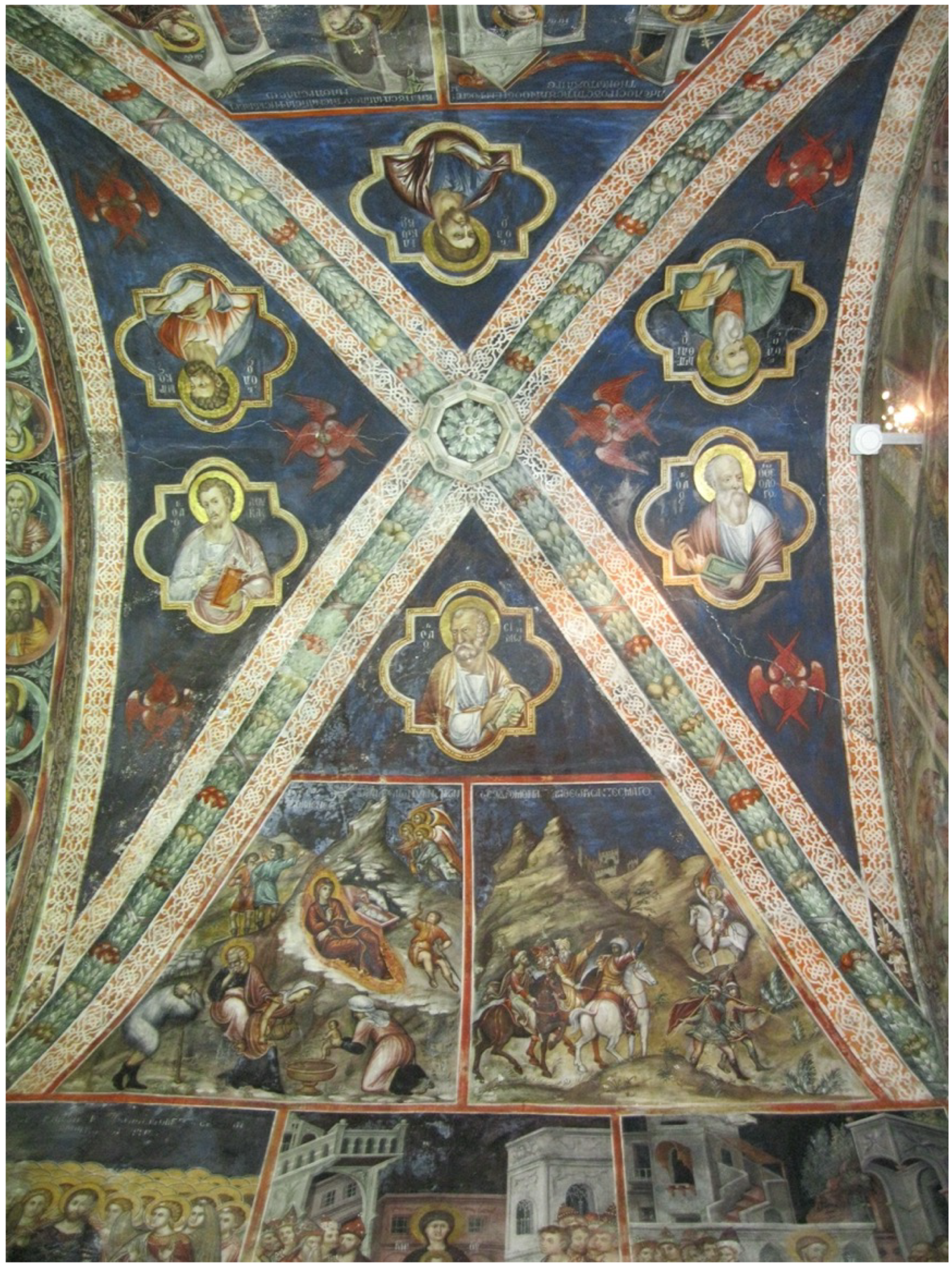
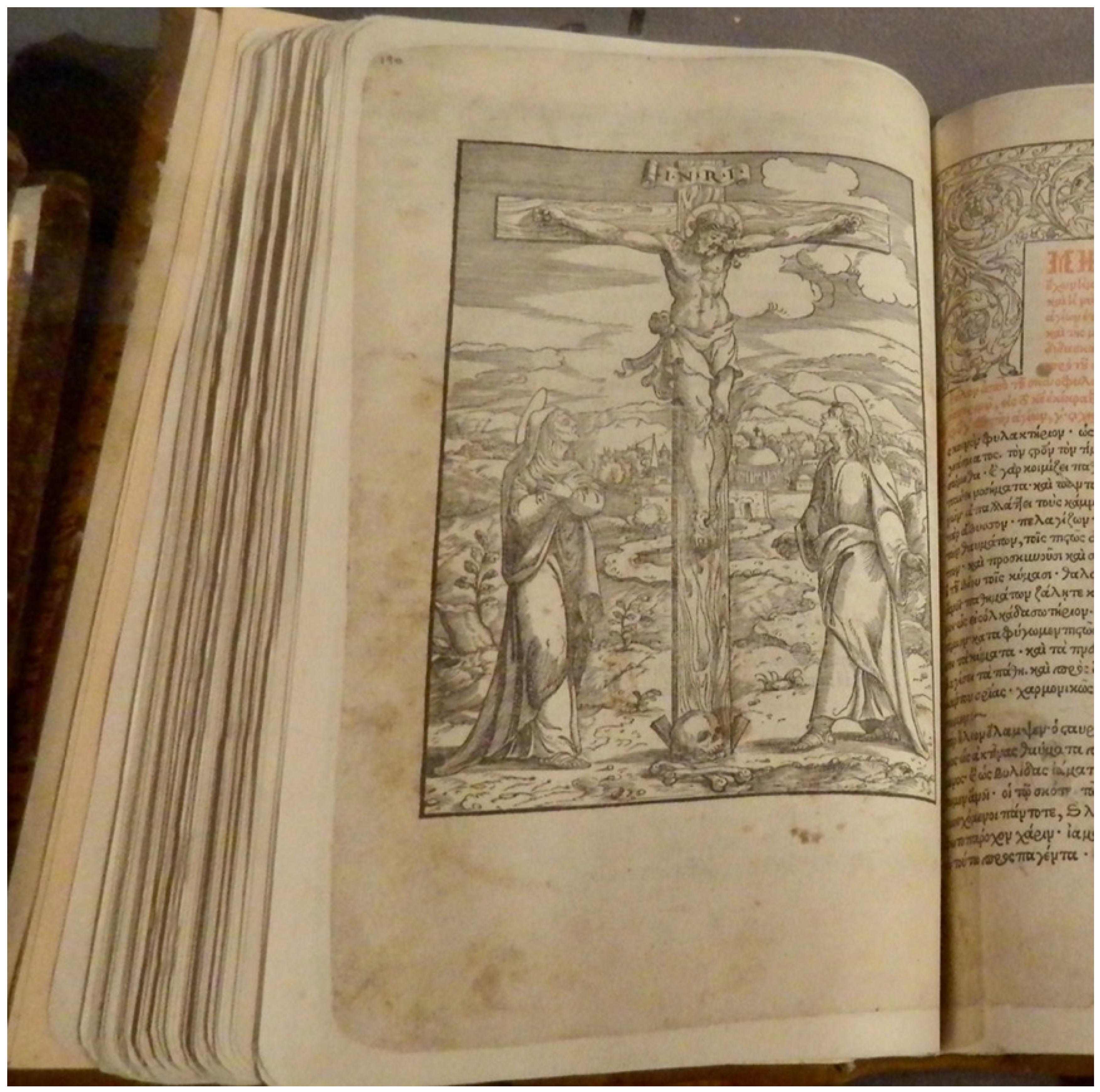
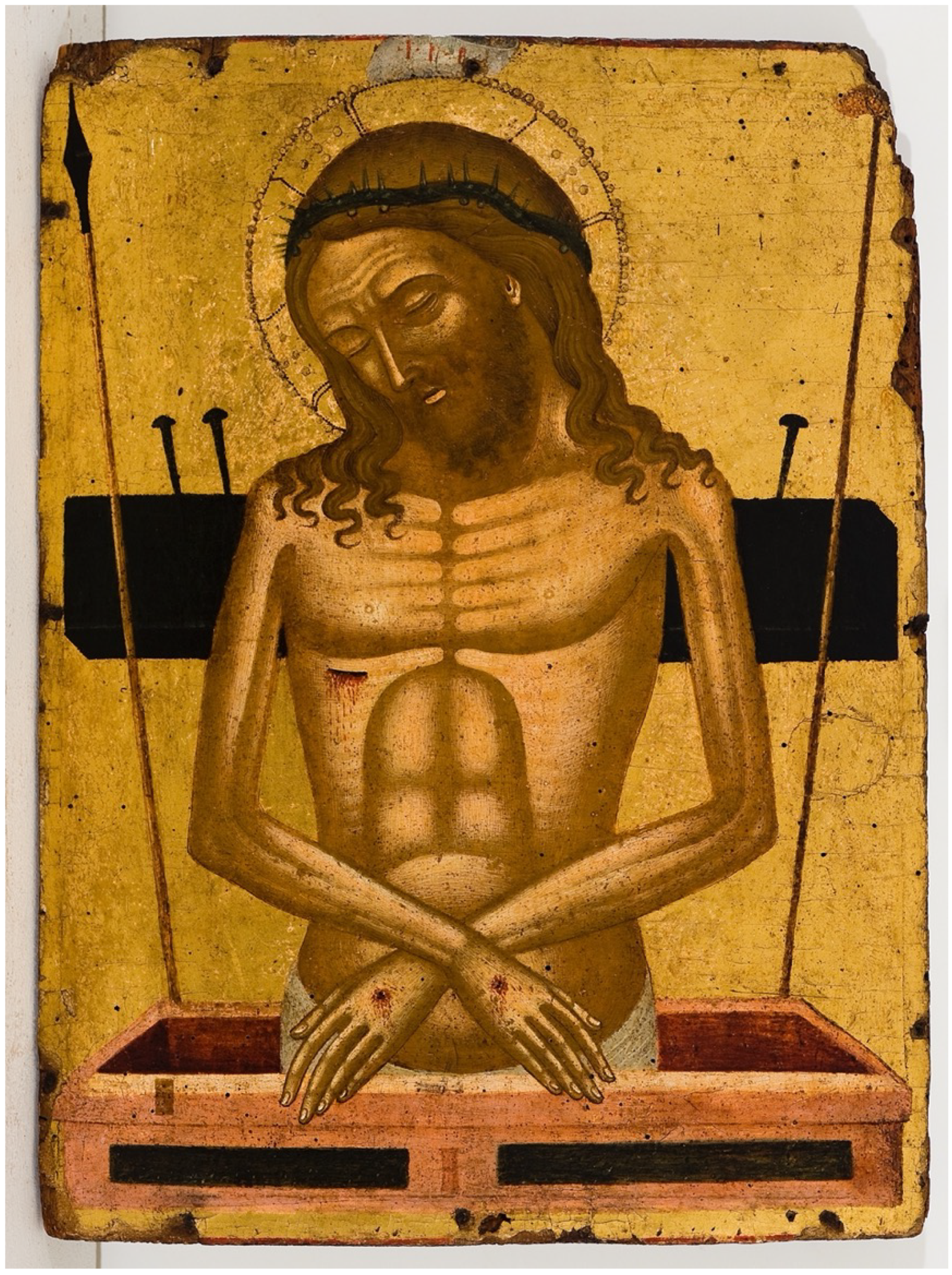
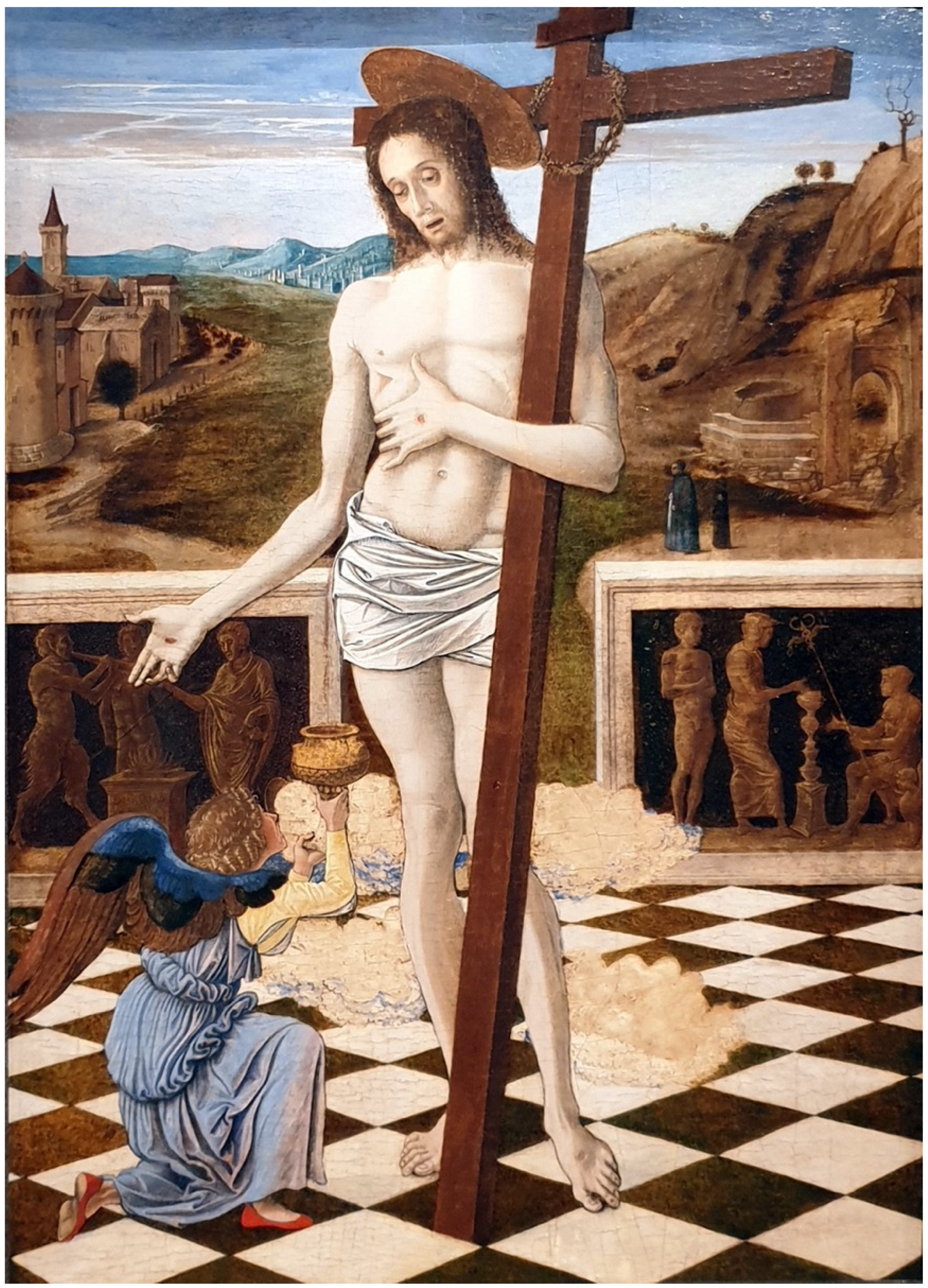


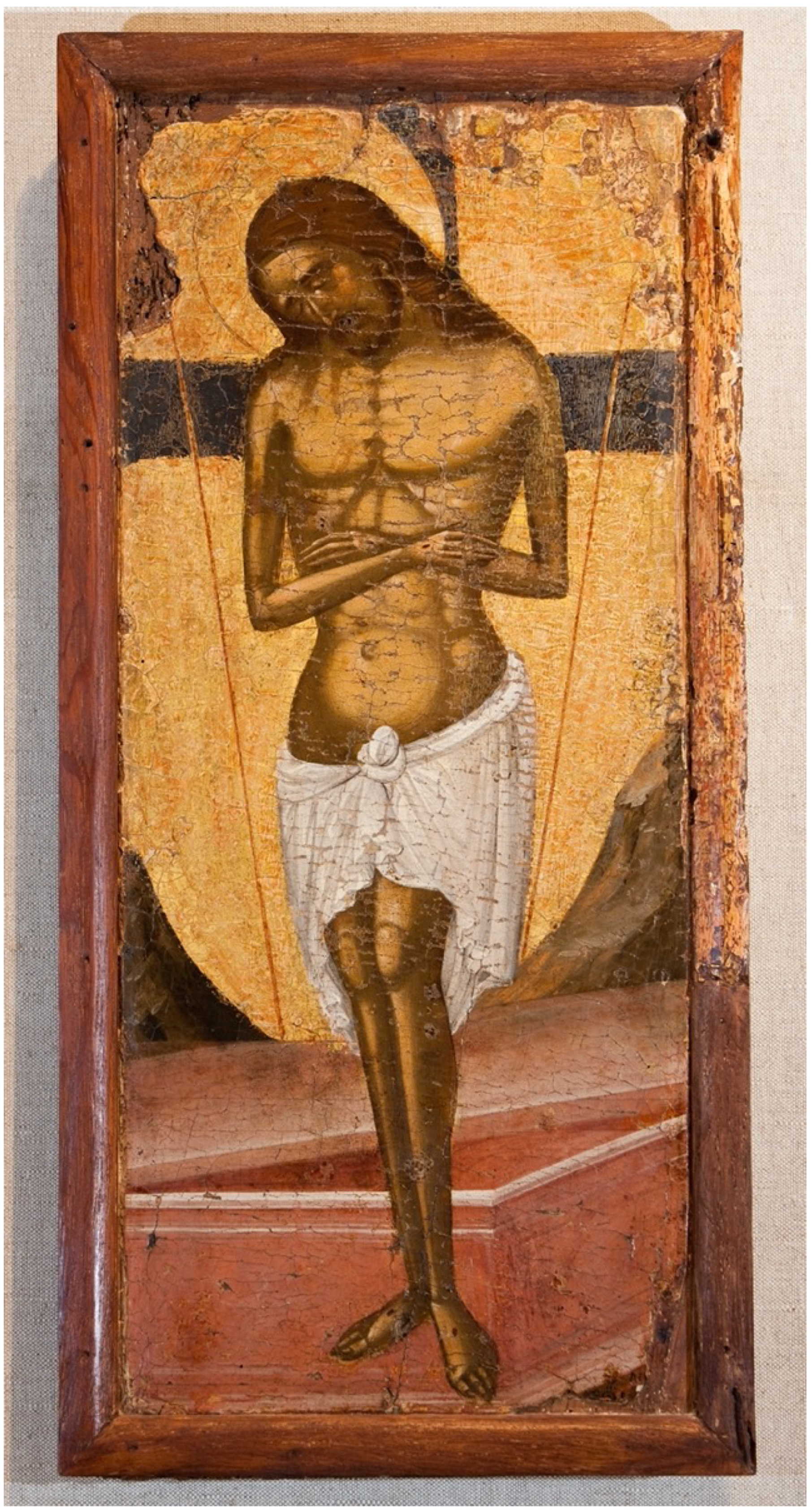
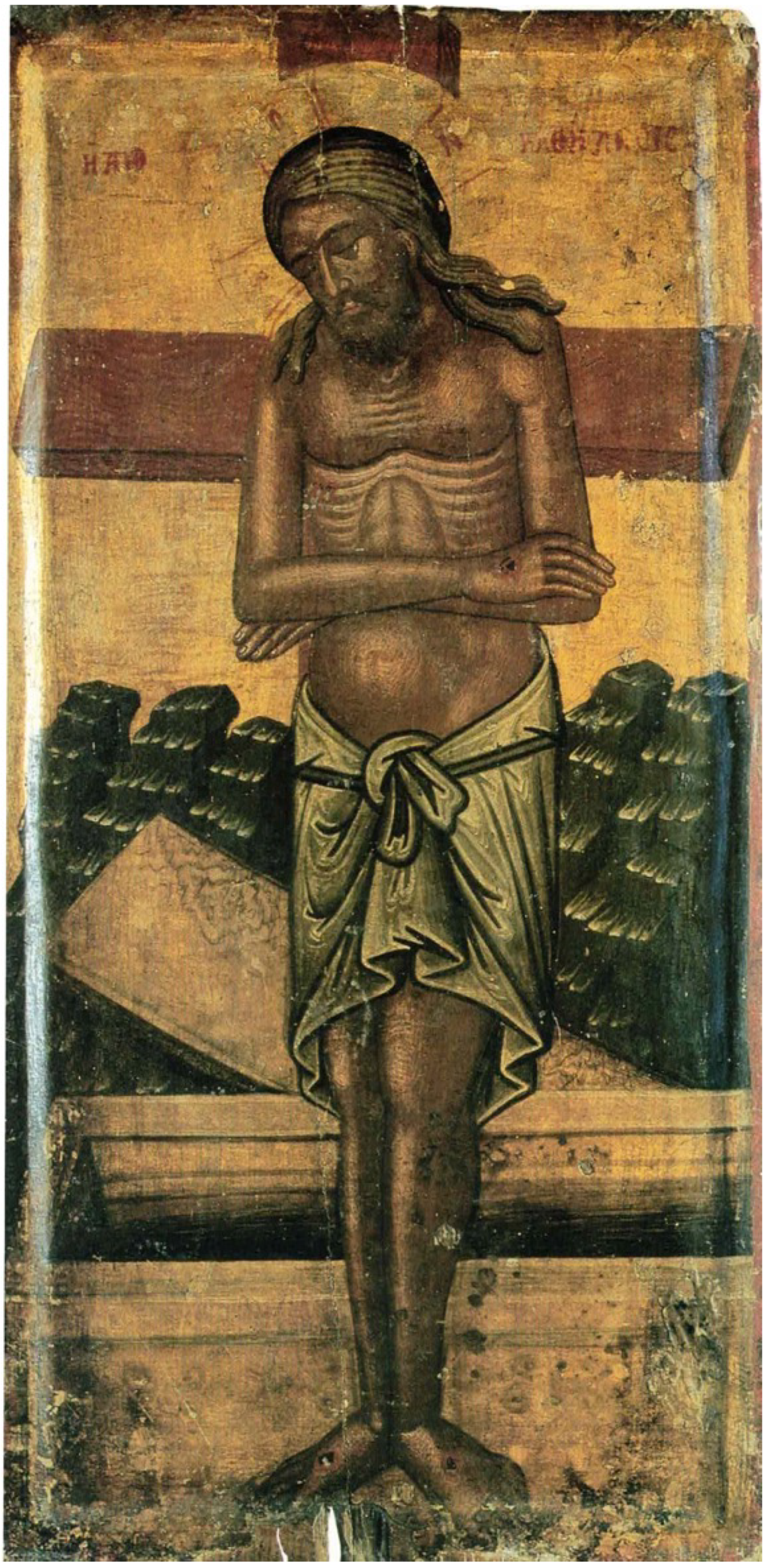
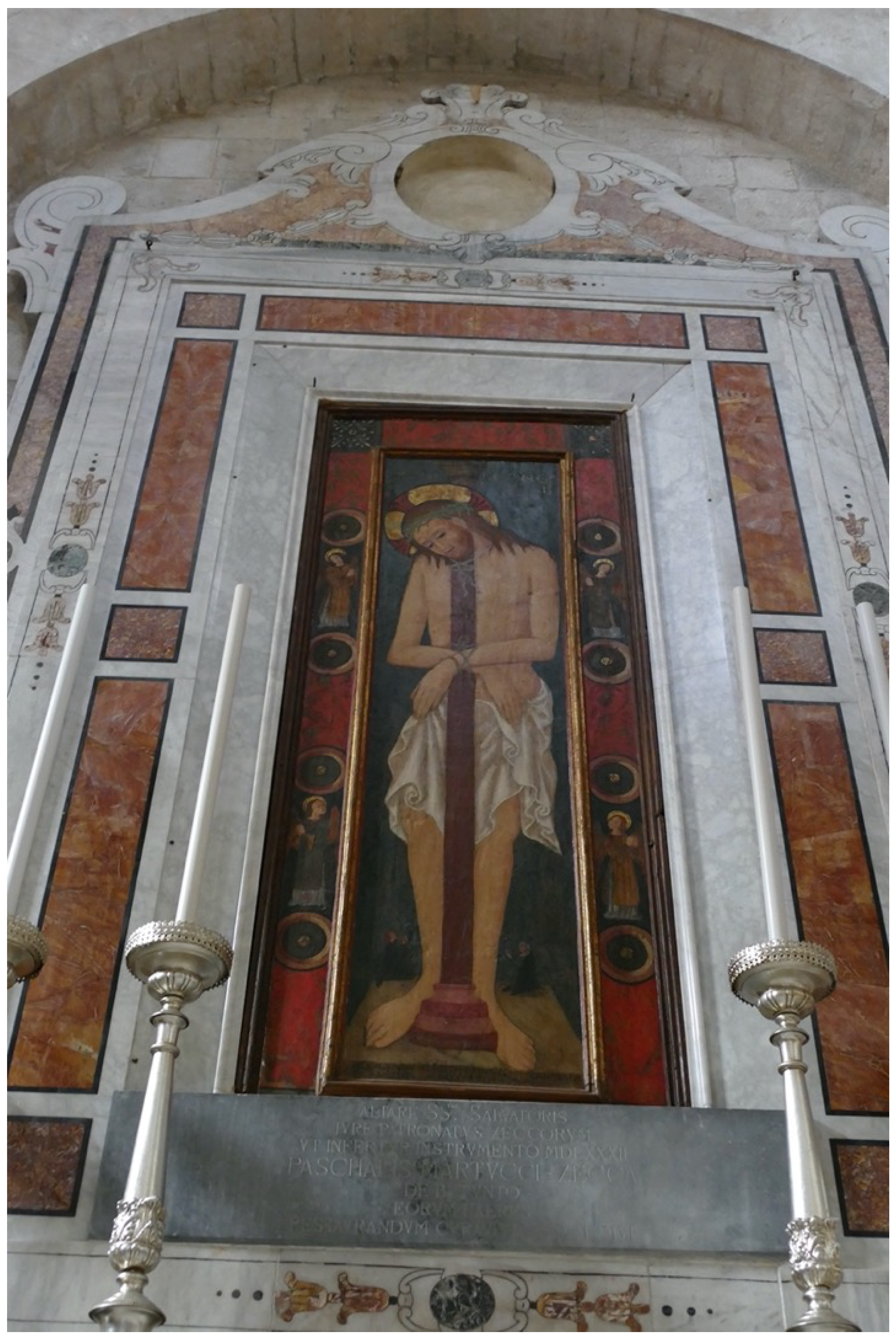


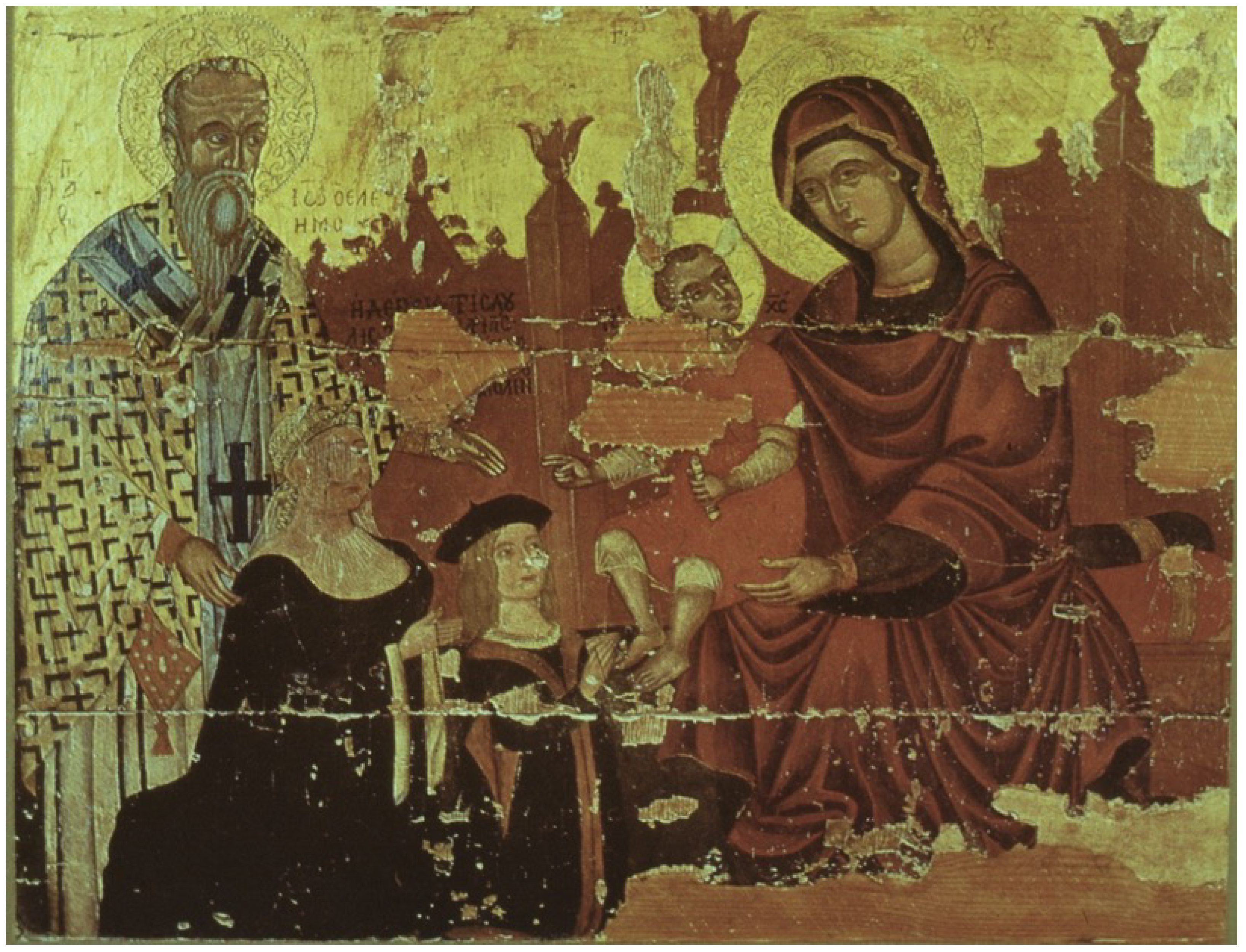

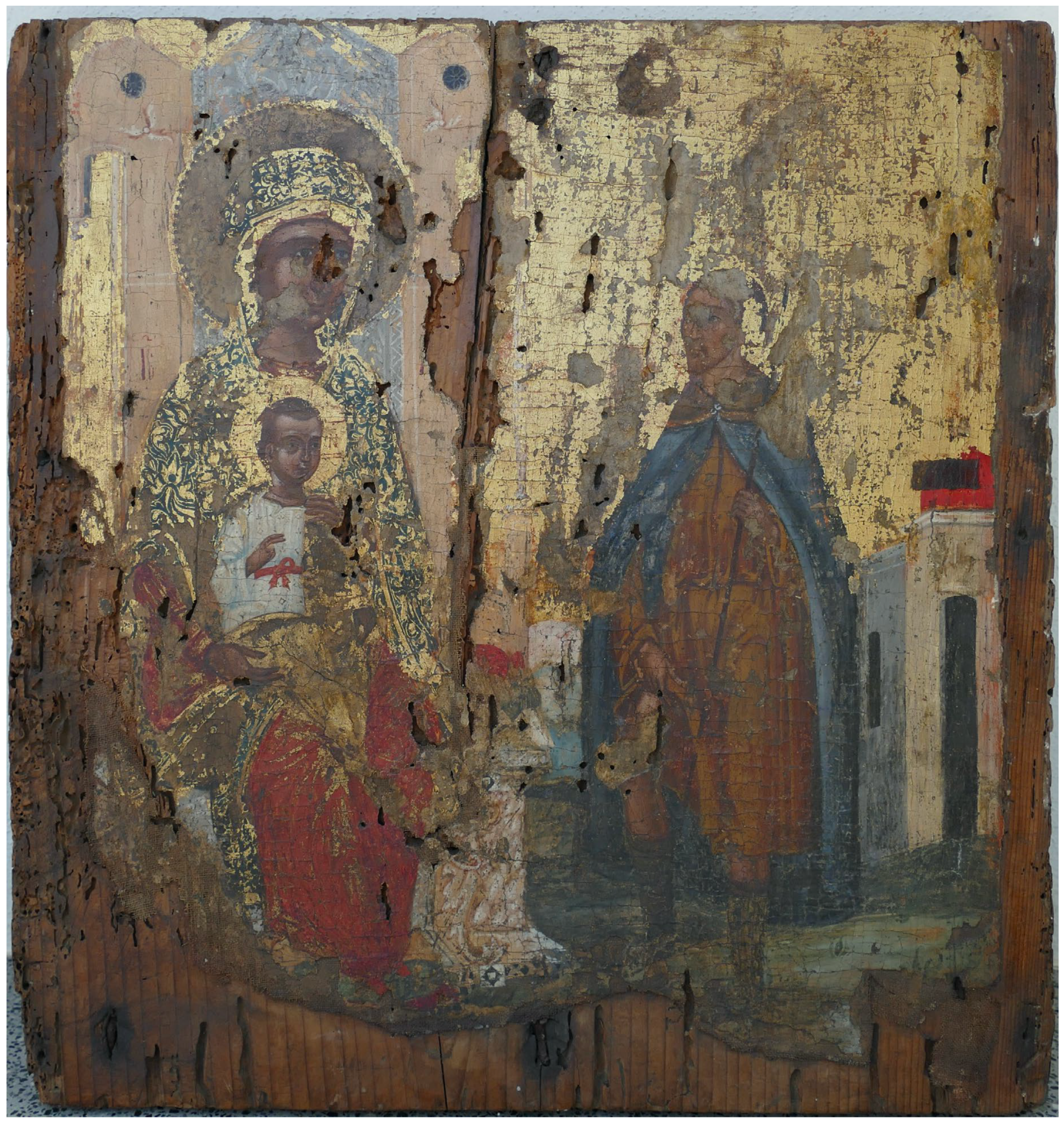
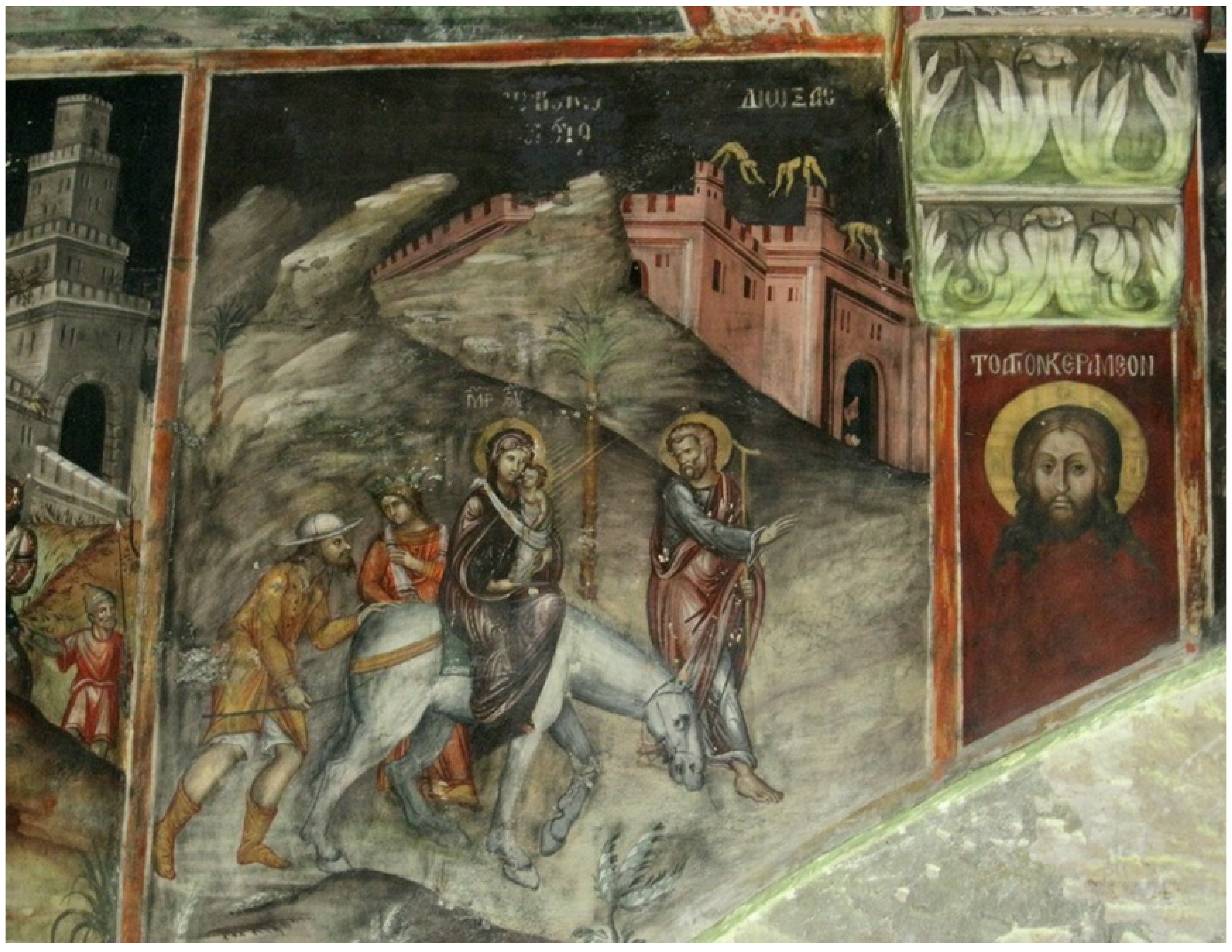


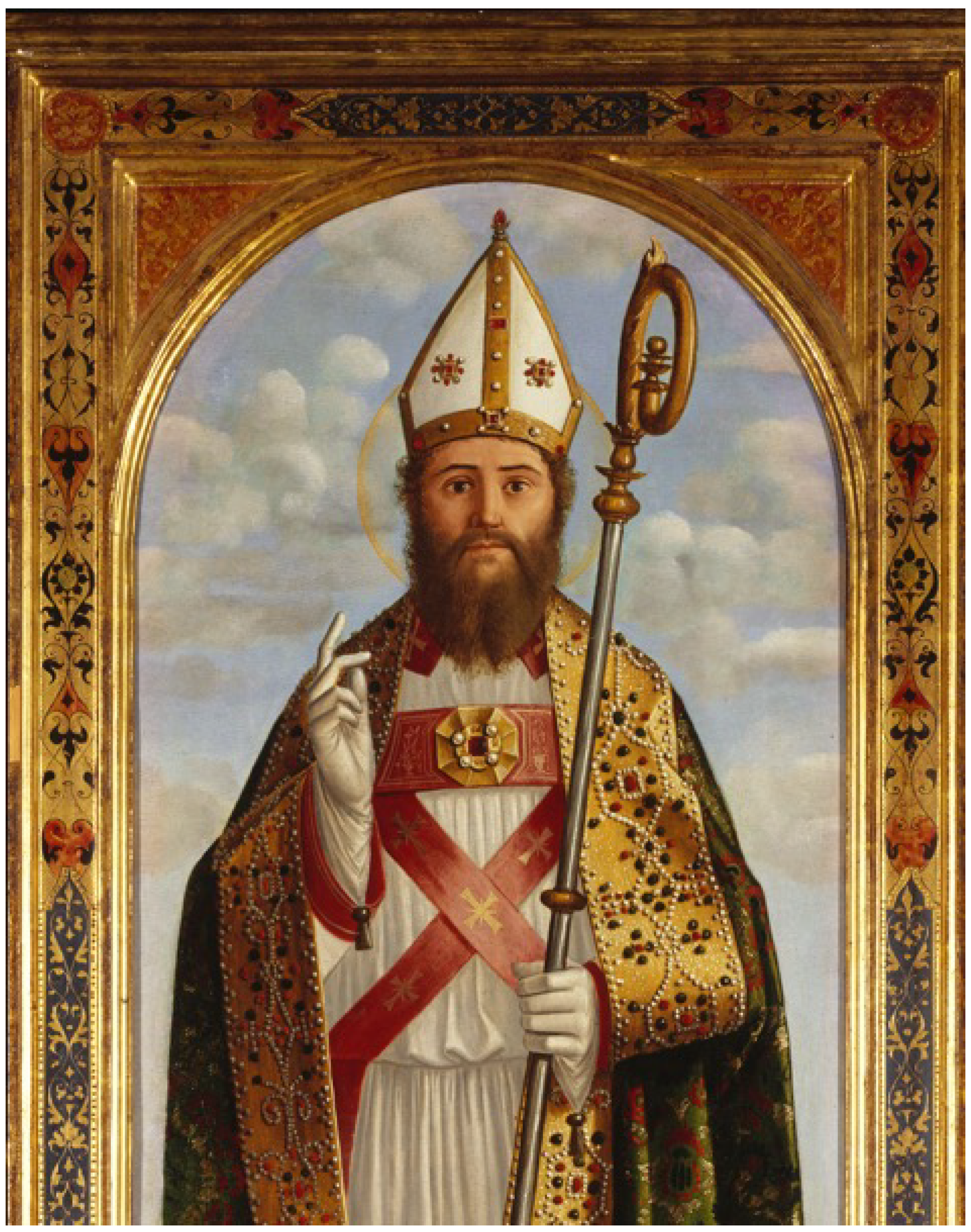
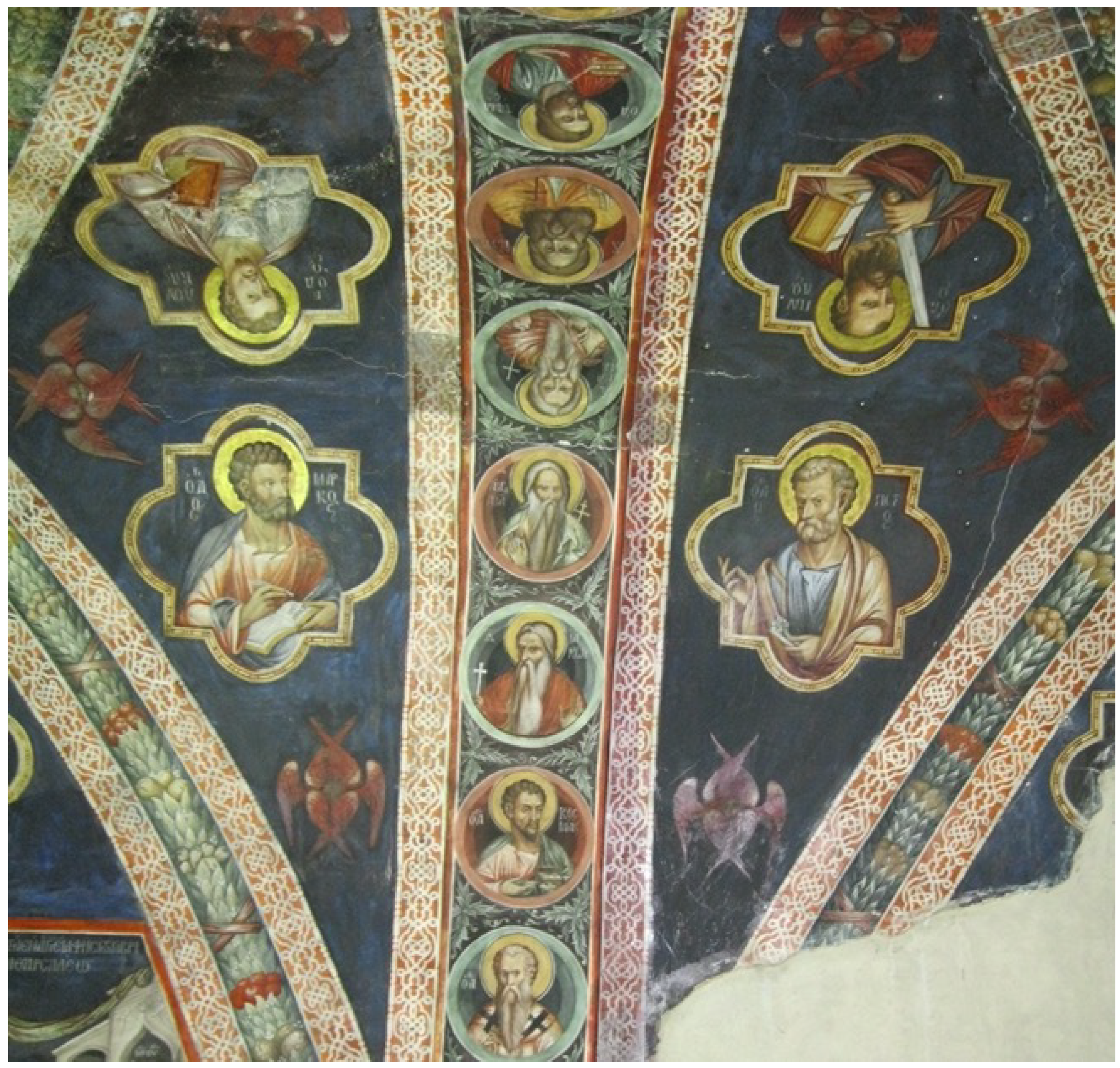
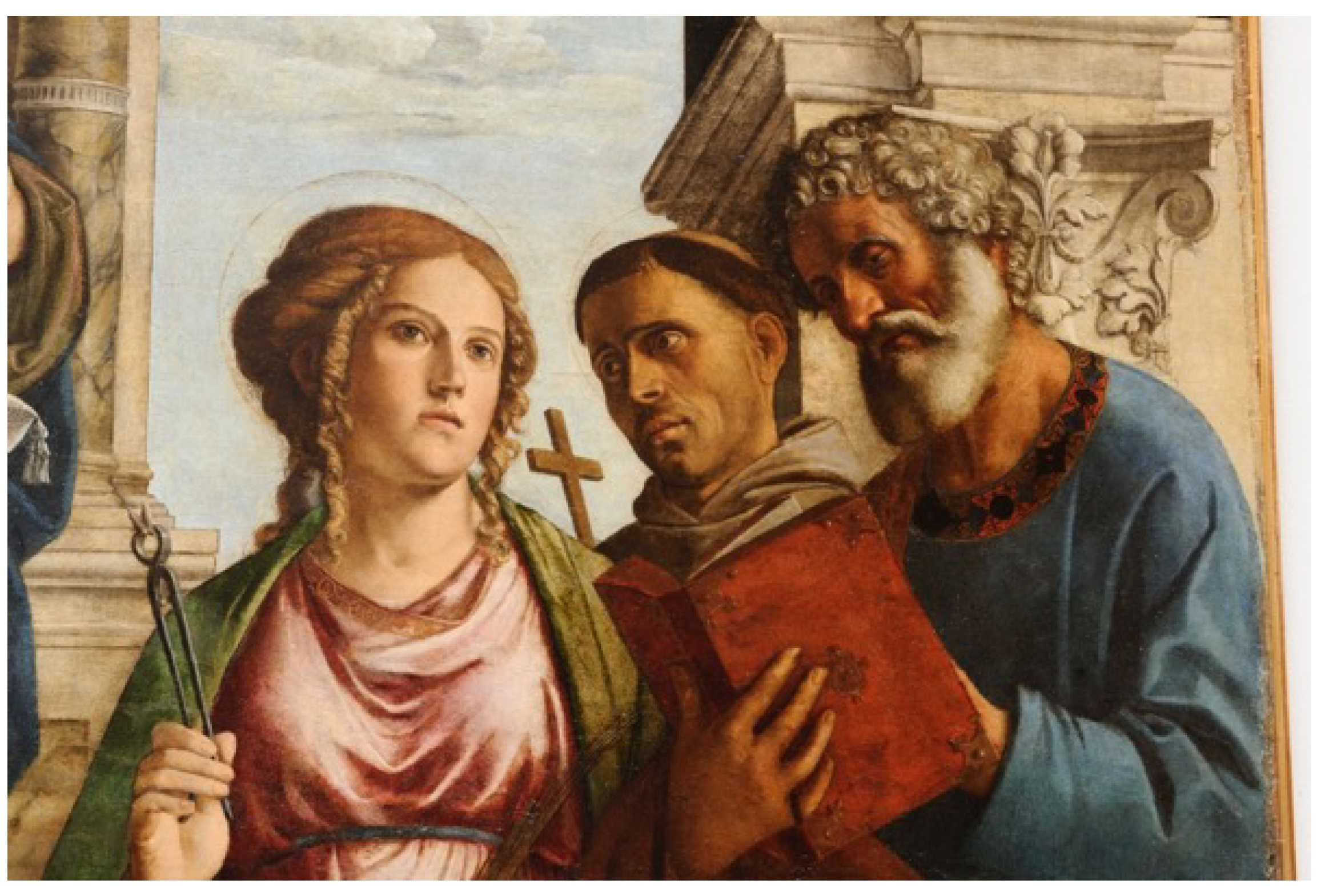


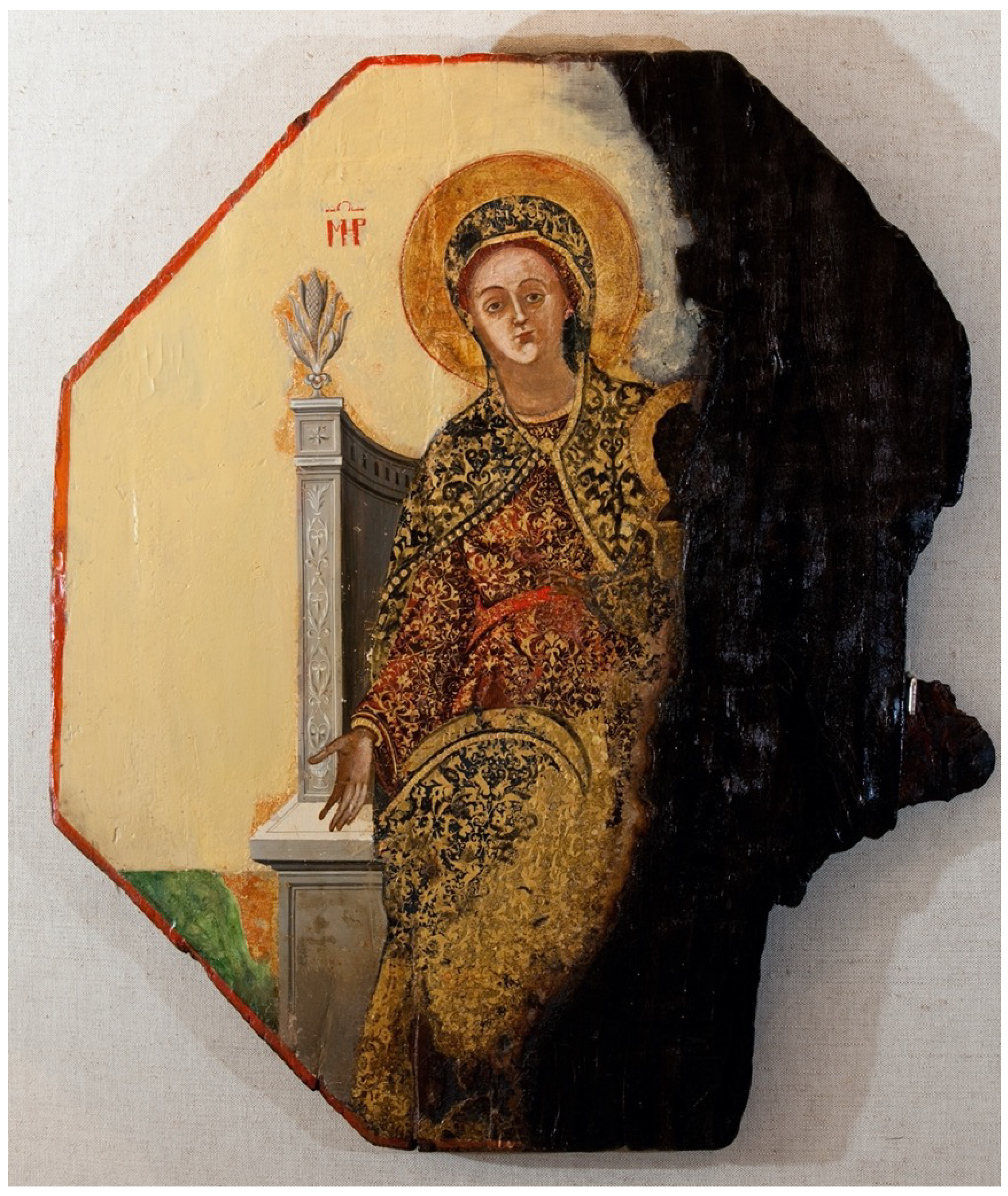
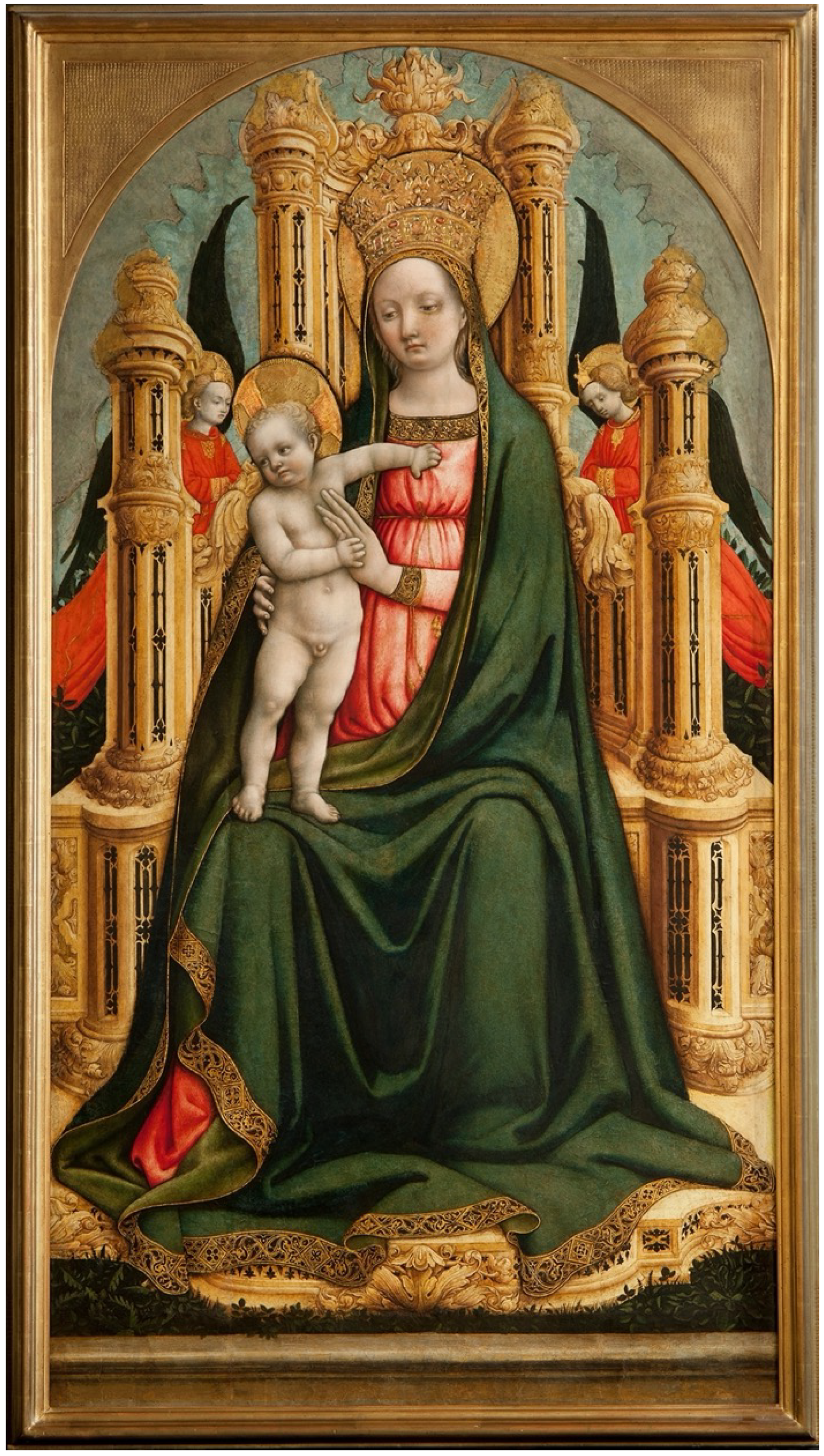
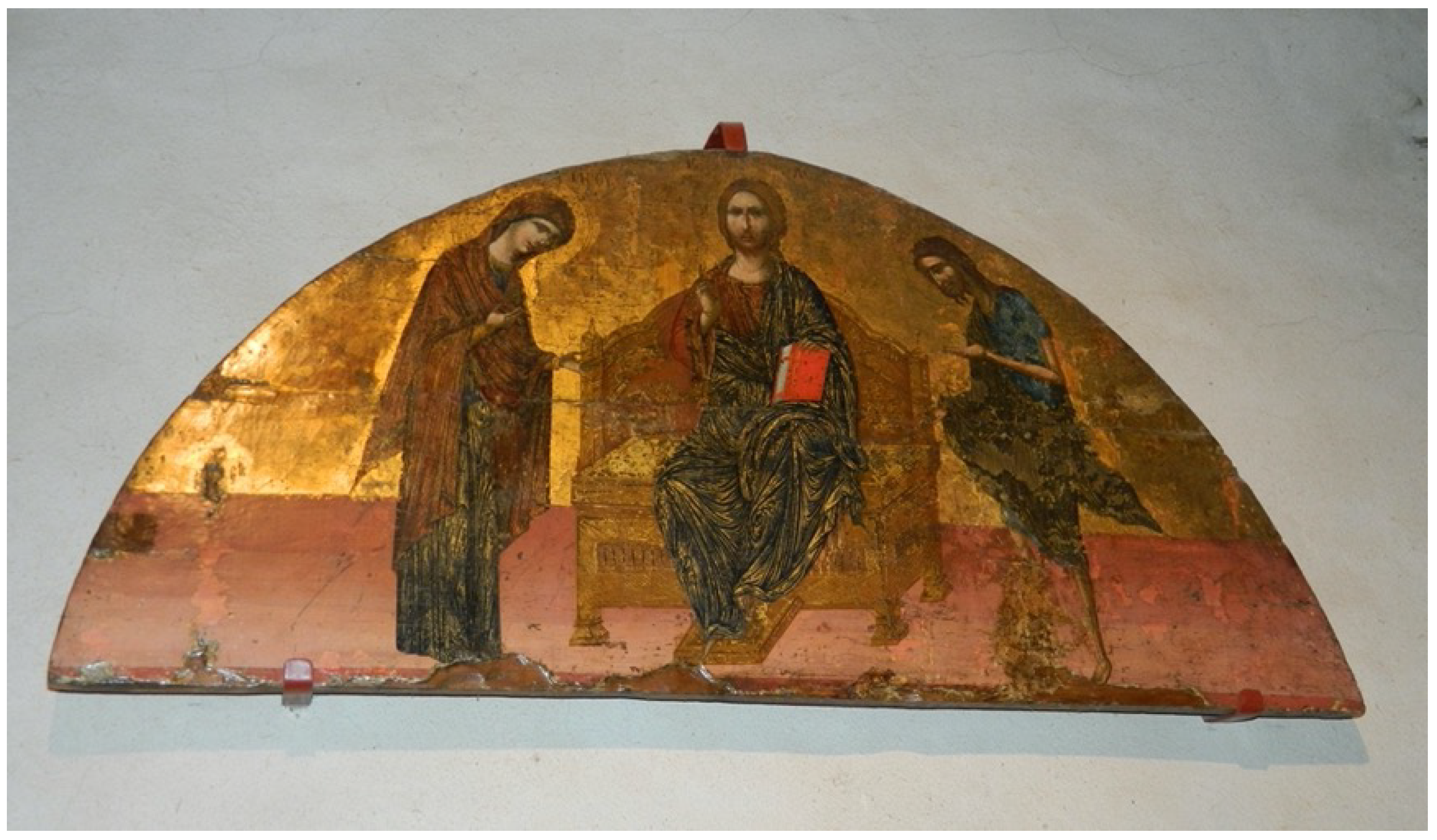
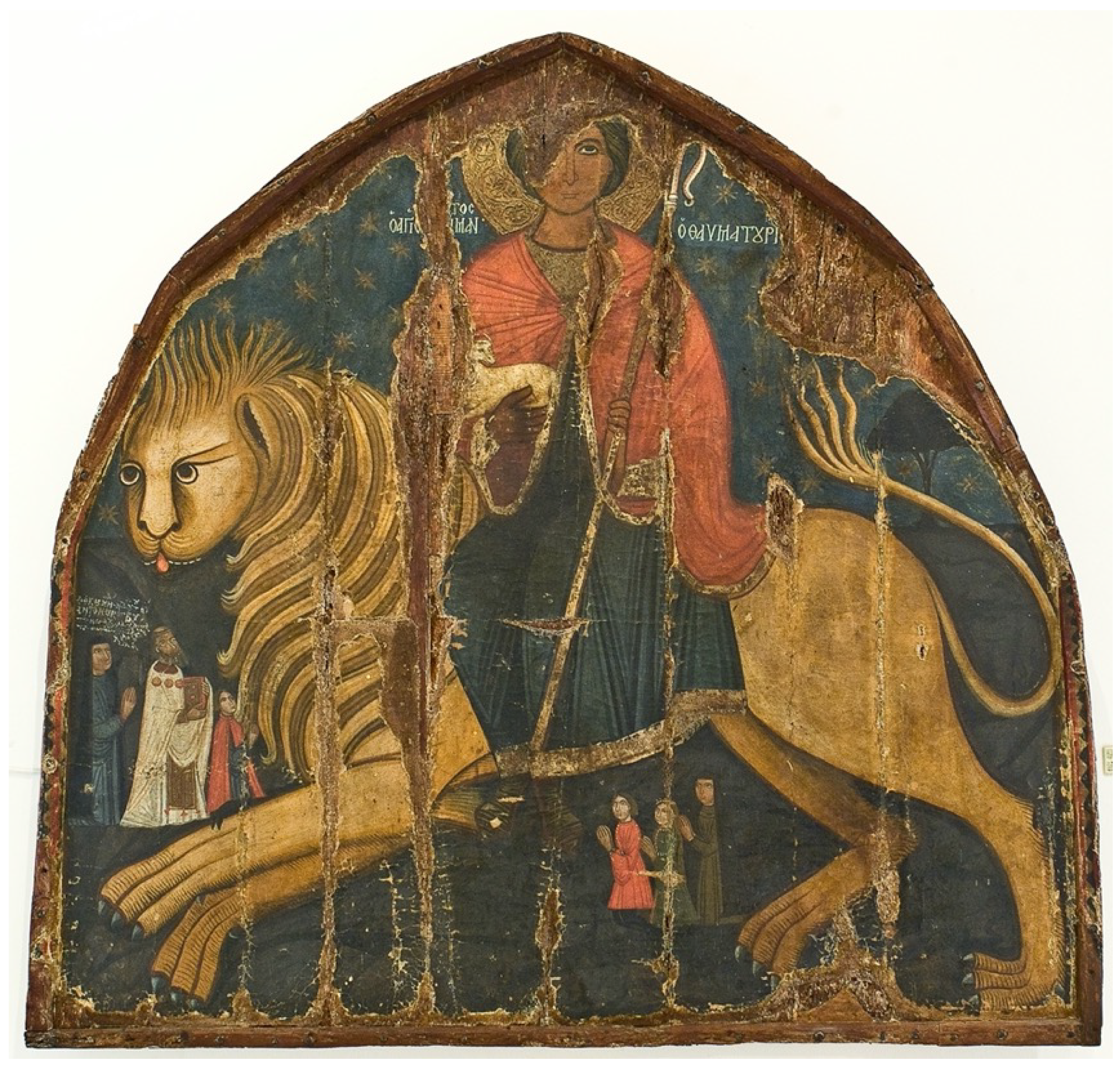

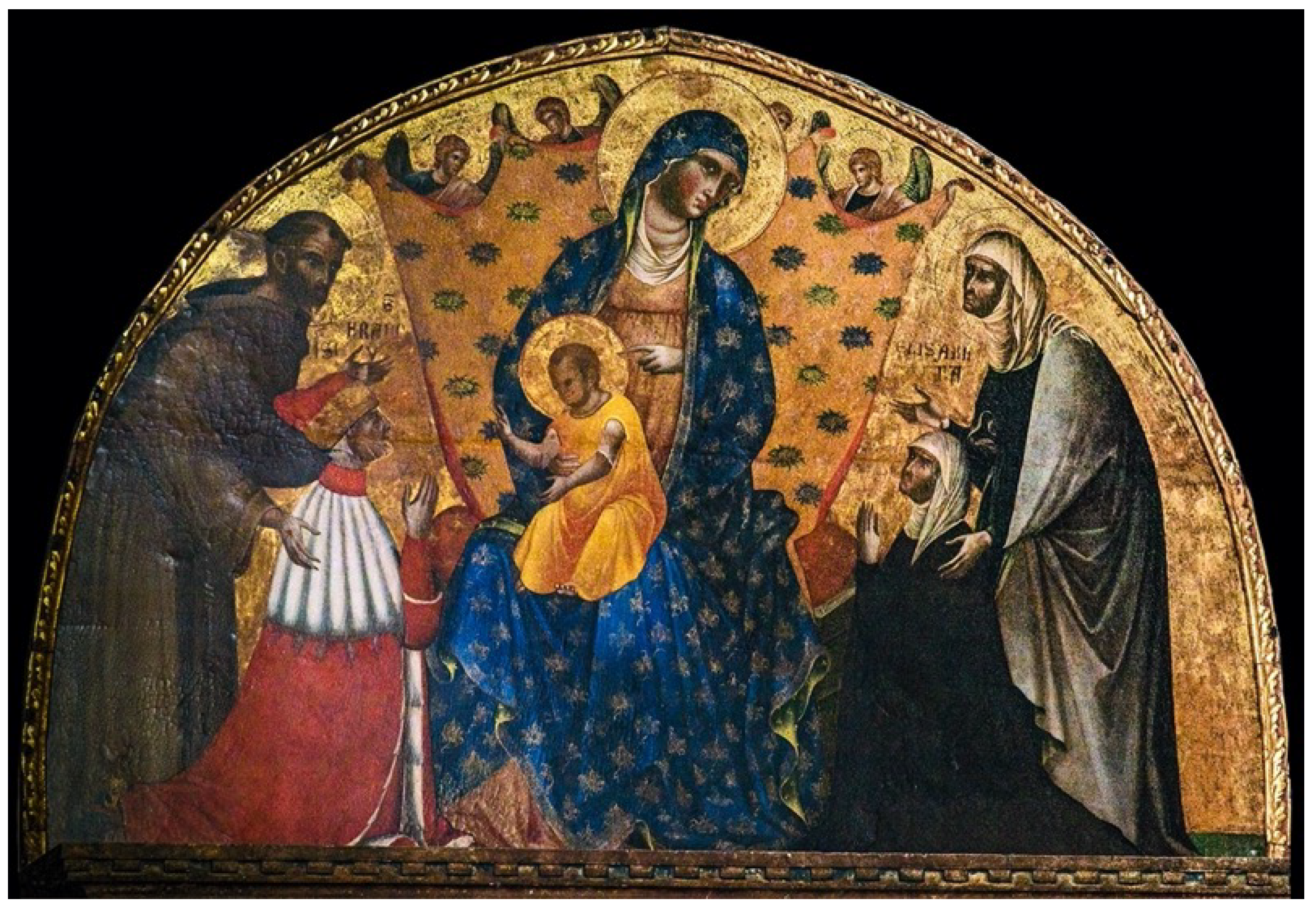
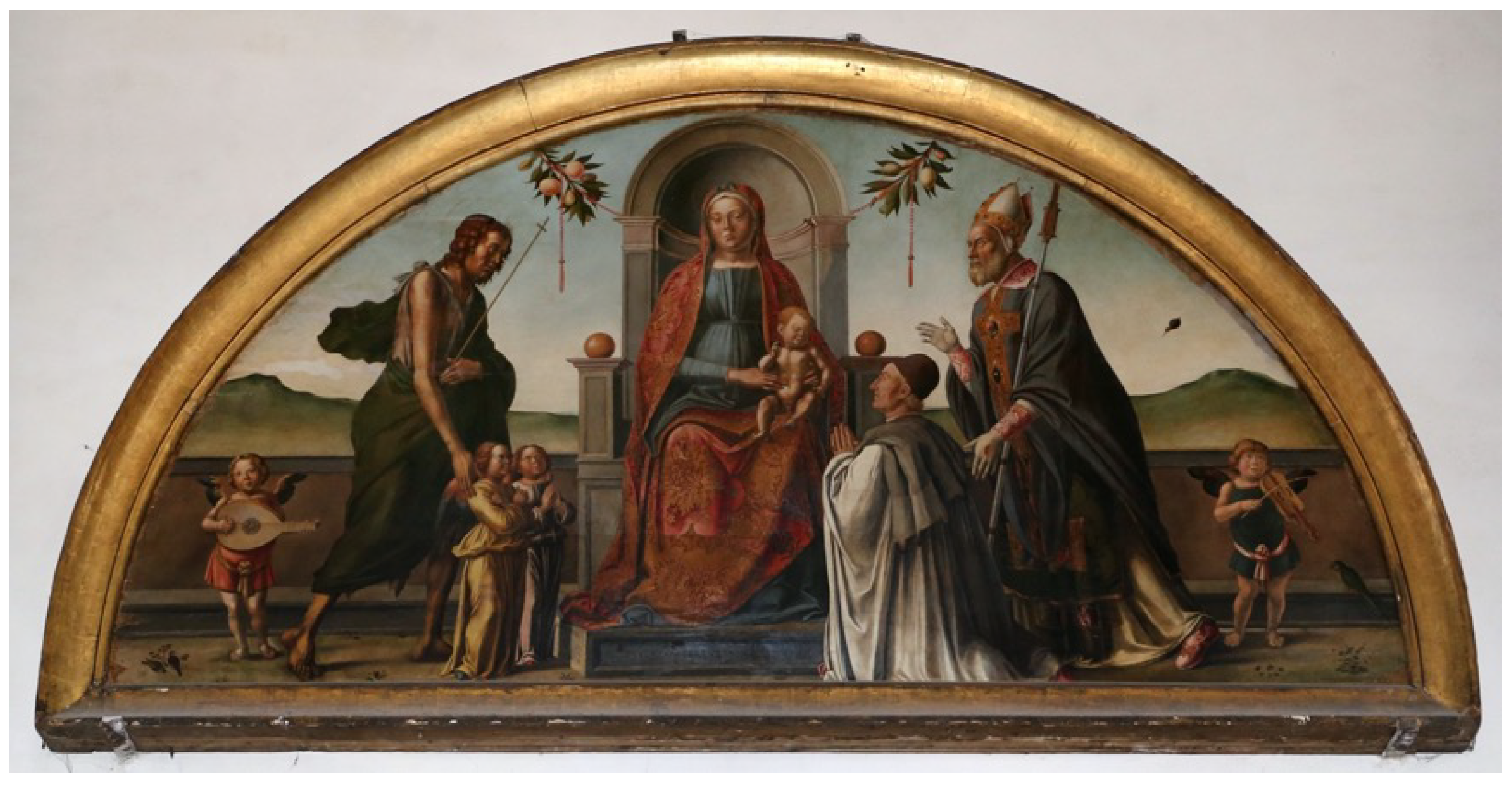
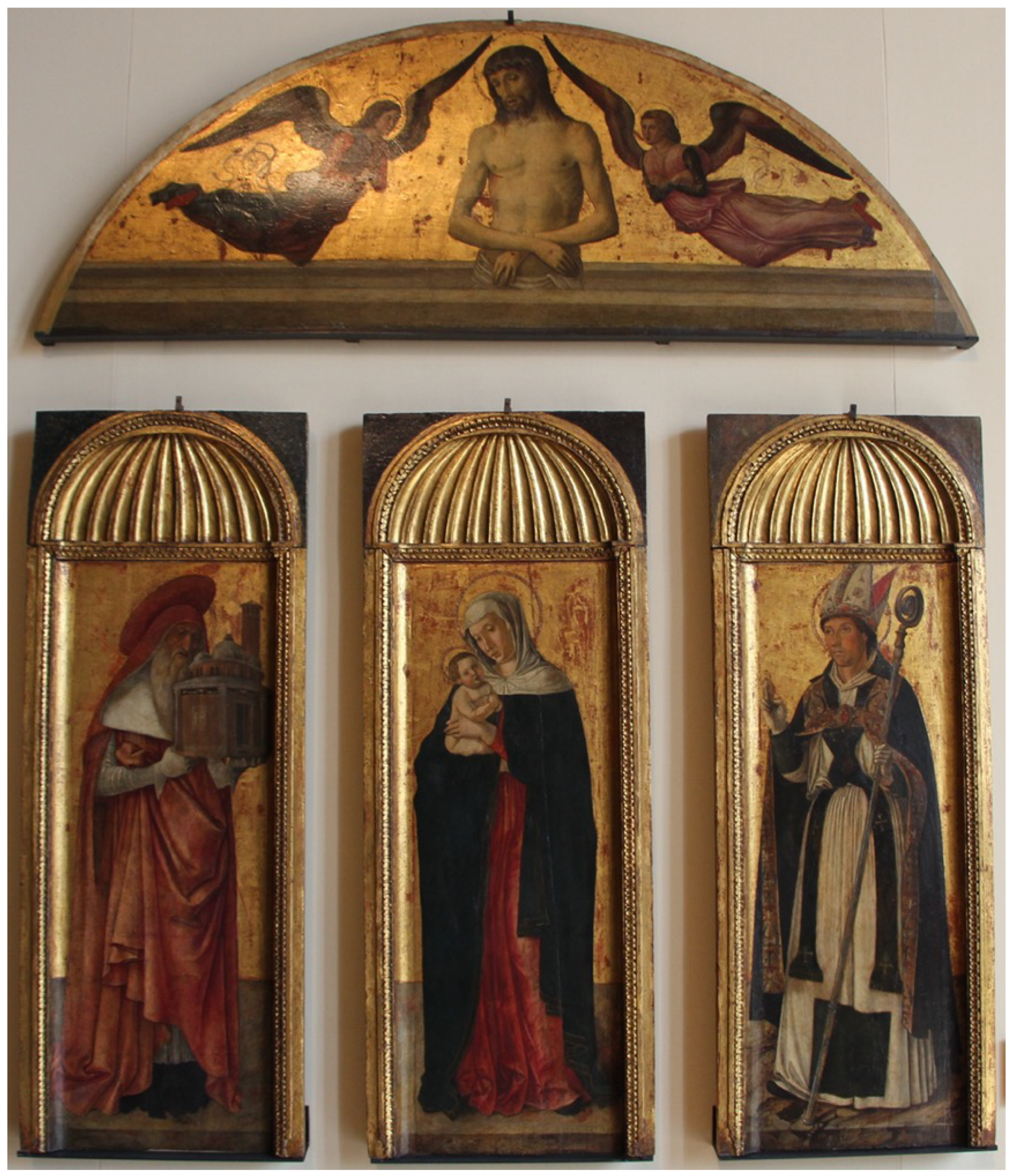
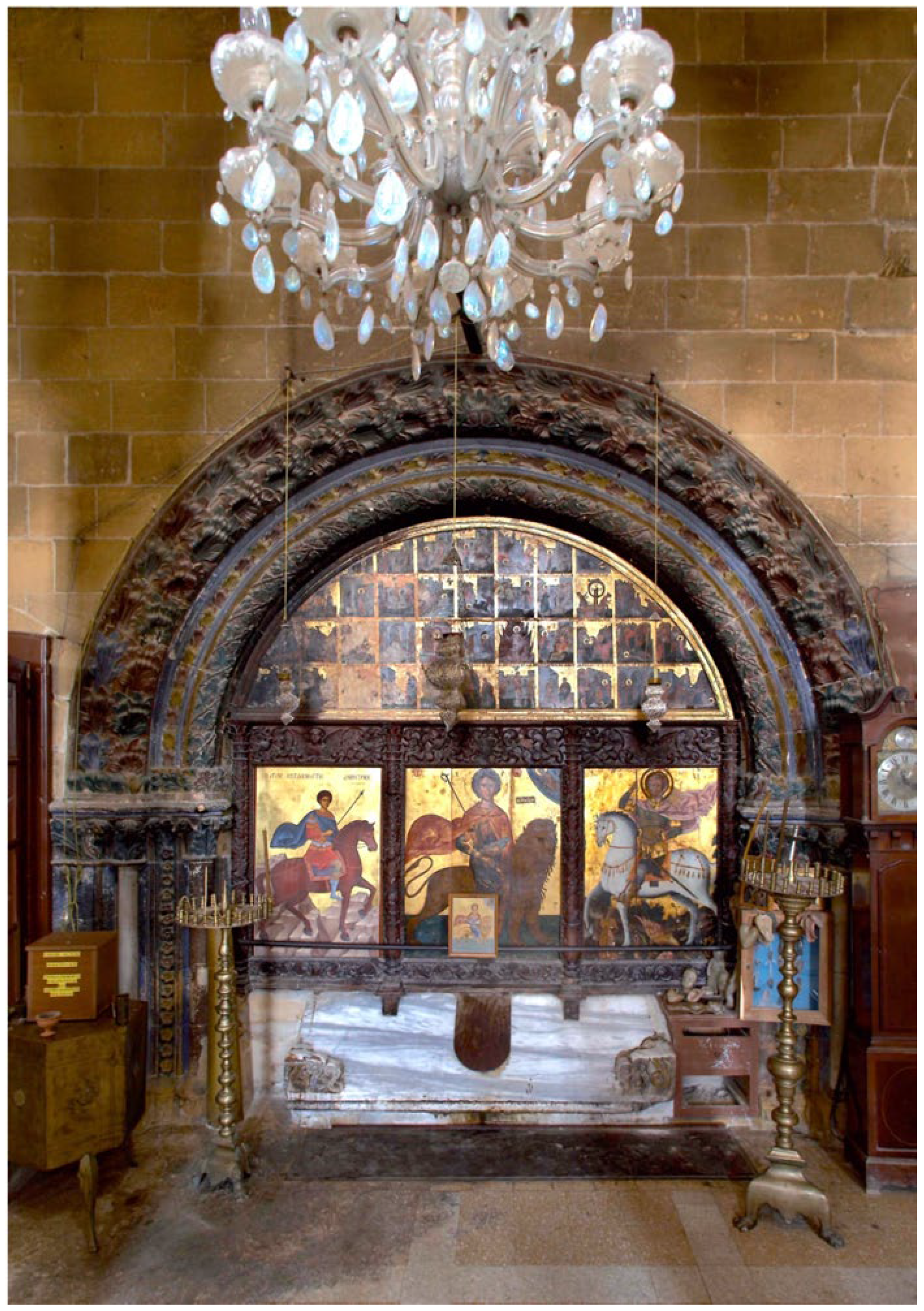
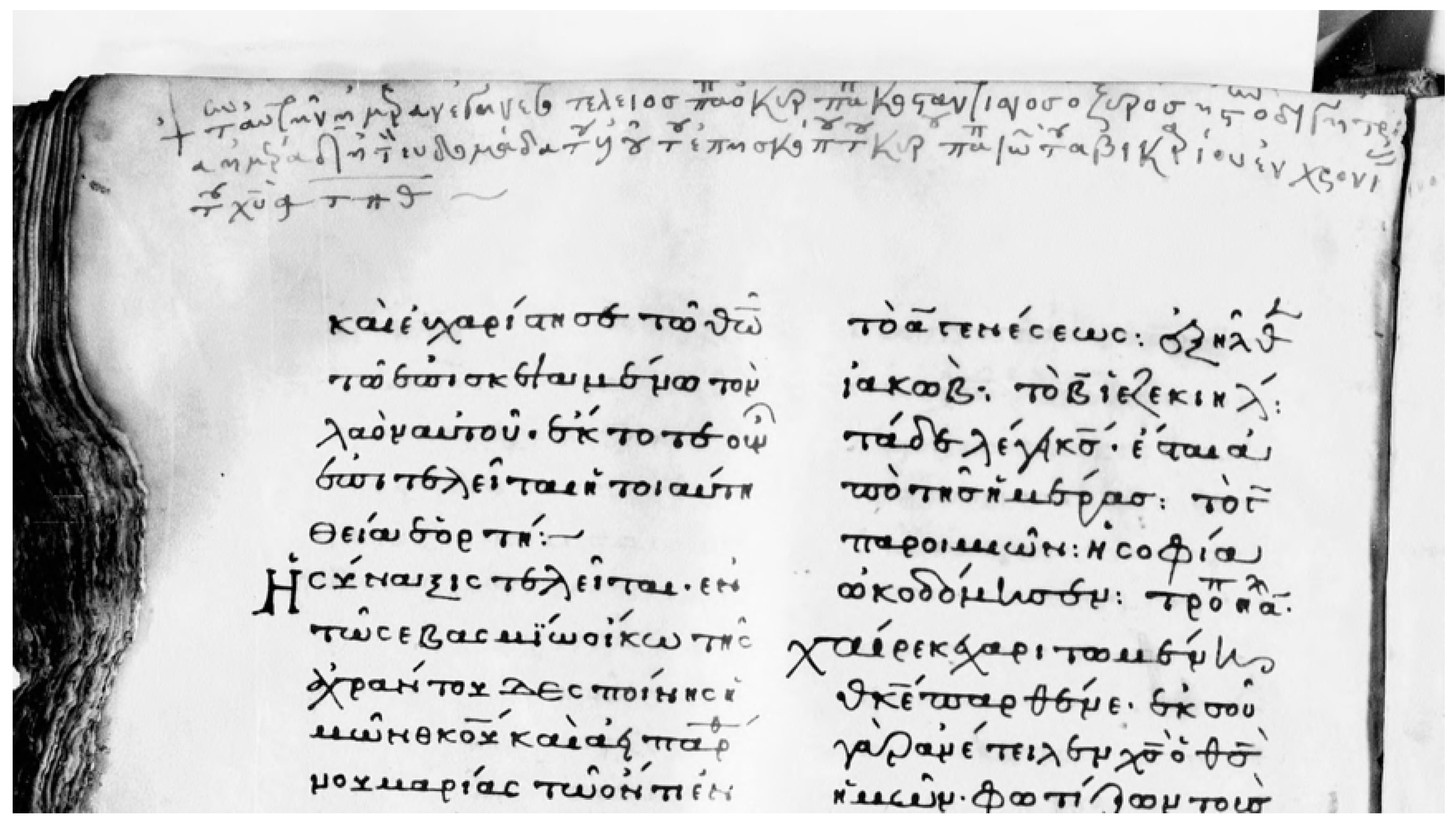
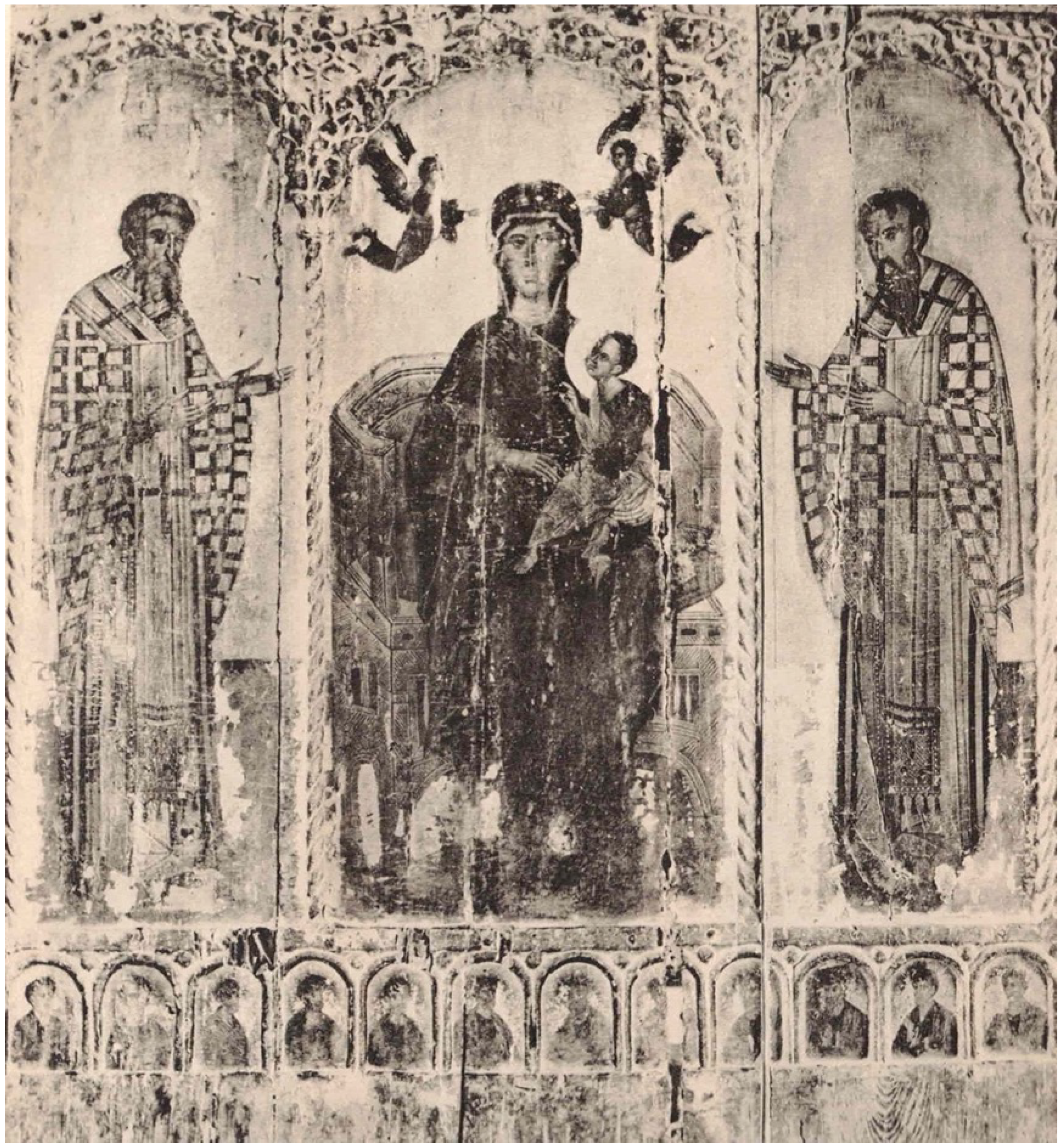


Disclaimer/Publisher’s Note: The statements, opinions and data contained in all publications are solely those of the individual author(s) and contributor(s) and not of MDPI and/or the editor(s). MDPI and/or the editor(s) disclaim responsibility for any injury to people or property resulting from any ideas, methods, instructions or products referred to in the content. |
© 2023 by the author. Licensee MDPI, Basel, Switzerland. This article is an open access article distributed under the terms and conditions of the Creative Commons Attribution (CC BY) license (https://creativecommons.org/licenses/by/4.0/).
Share and Cite
Andronikou, A. La Serenissima in Cyprus: Aspects of Venetian Art on the Edge of a Maritime Empire, 1474/89–1570/1. Arts 2023, 12, 186. https://doi.org/10.3390/arts12050186
Andronikou A. La Serenissima in Cyprus: Aspects of Venetian Art on the Edge of a Maritime Empire, 1474/89–1570/1. Arts. 2023; 12(5):186. https://doi.org/10.3390/arts12050186
Chicago/Turabian StyleAndronikou, Anthi. 2023. "La Serenissima in Cyprus: Aspects of Venetian Art on the Edge of a Maritime Empire, 1474/89–1570/1" Arts 12, no. 5: 186. https://doi.org/10.3390/arts12050186
APA StyleAndronikou, A. (2023). La Serenissima in Cyprus: Aspects of Venetian Art on the Edge of a Maritime Empire, 1474/89–1570/1. Arts, 12(5), 186. https://doi.org/10.3390/arts12050186



